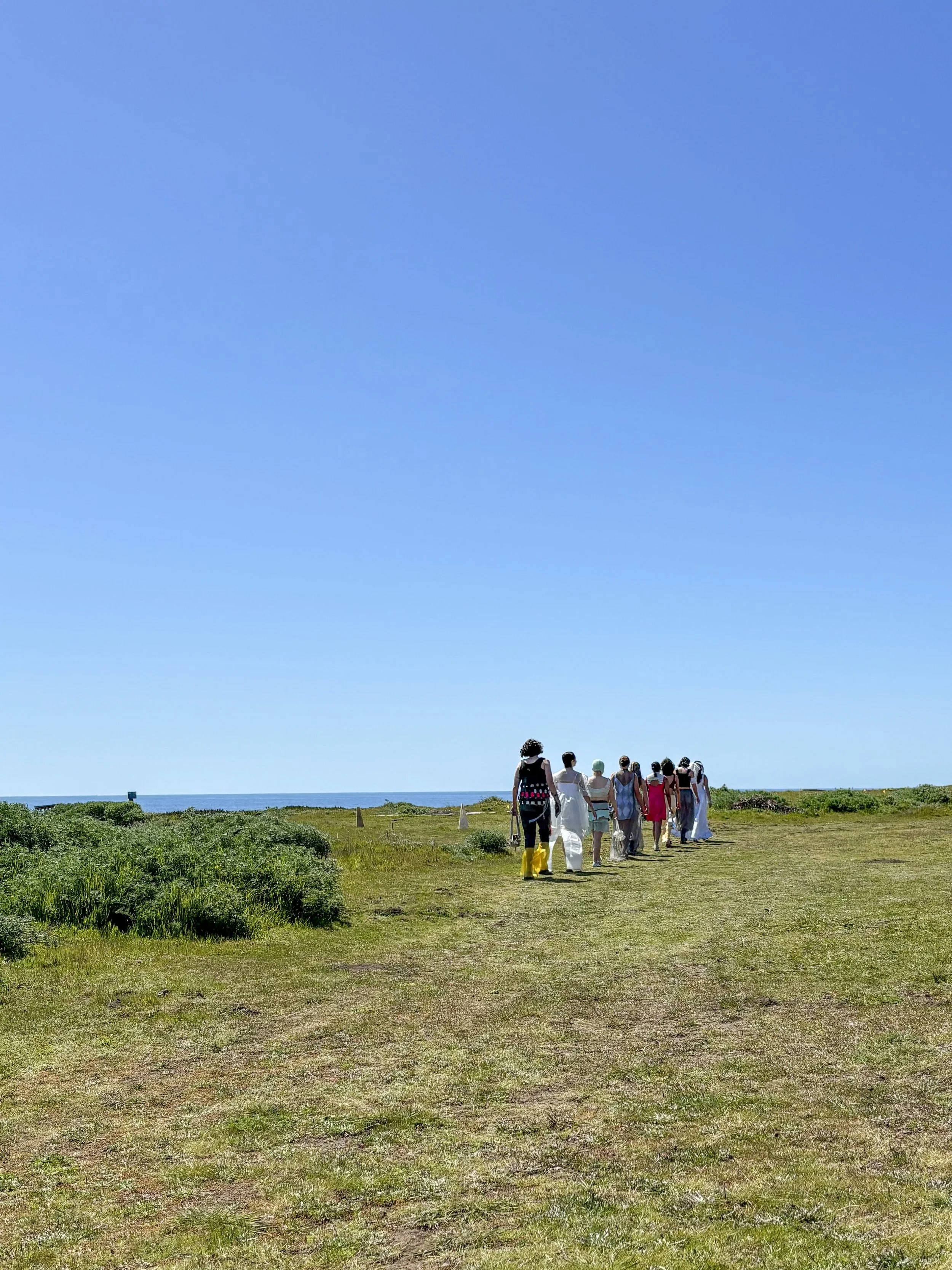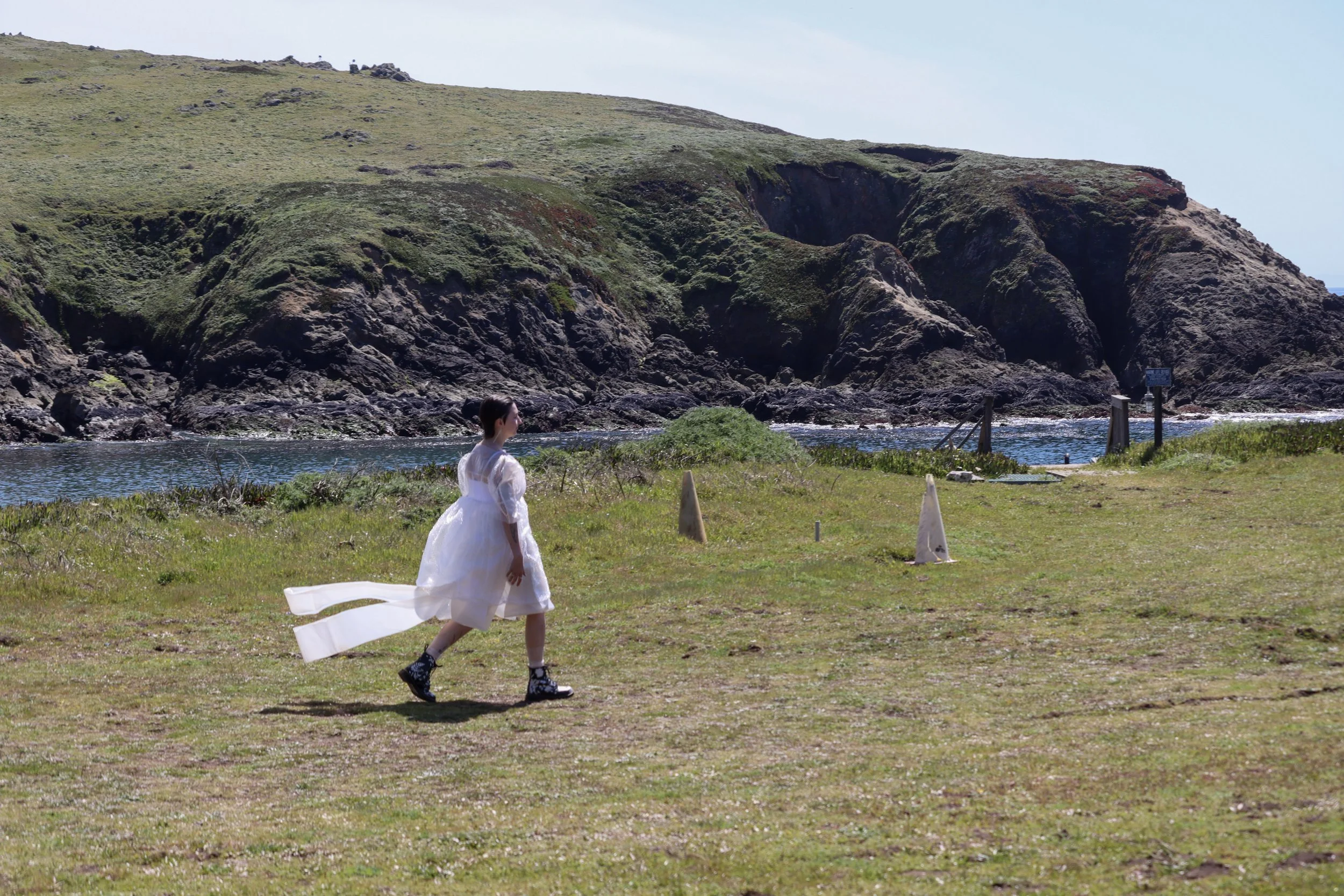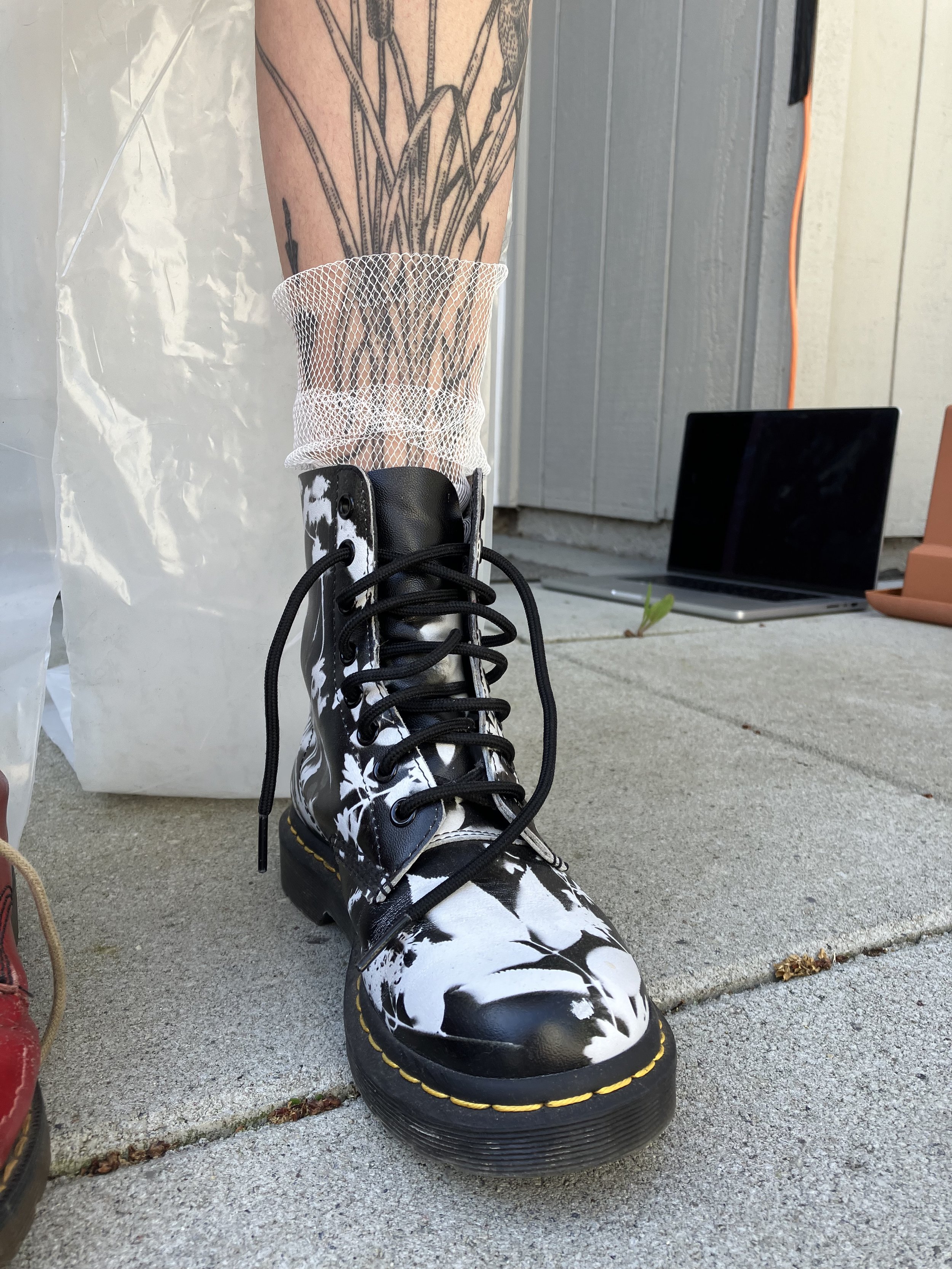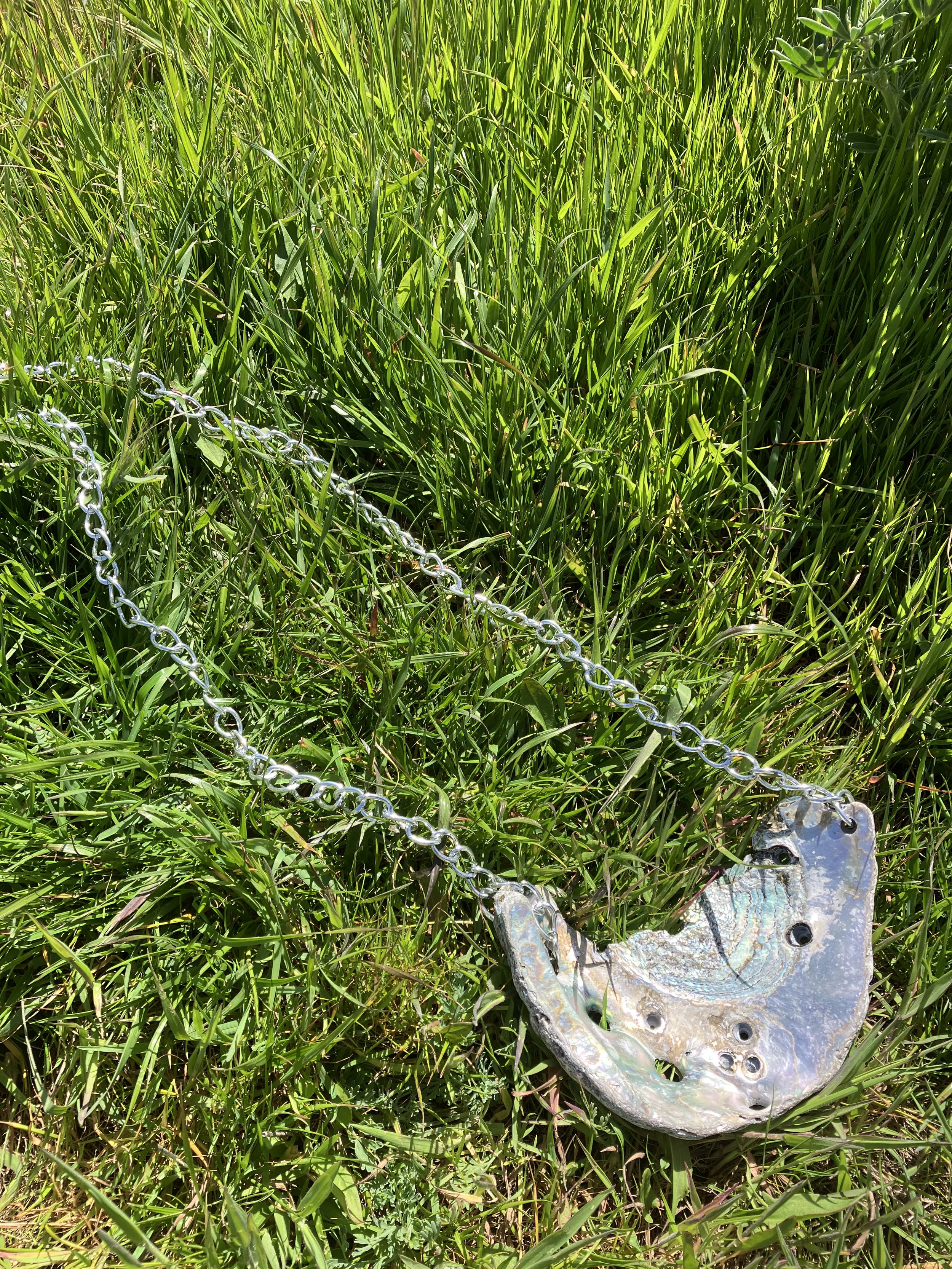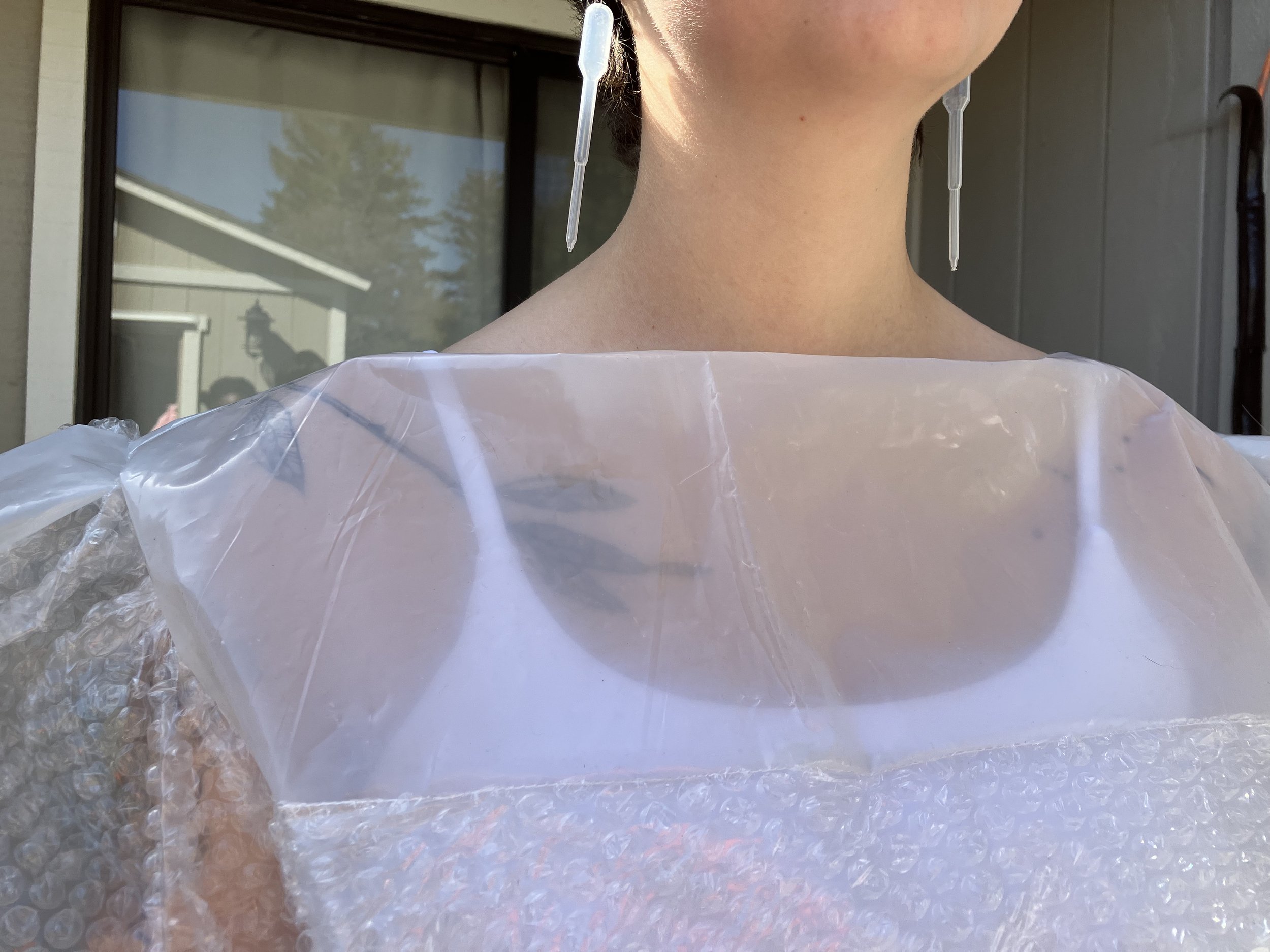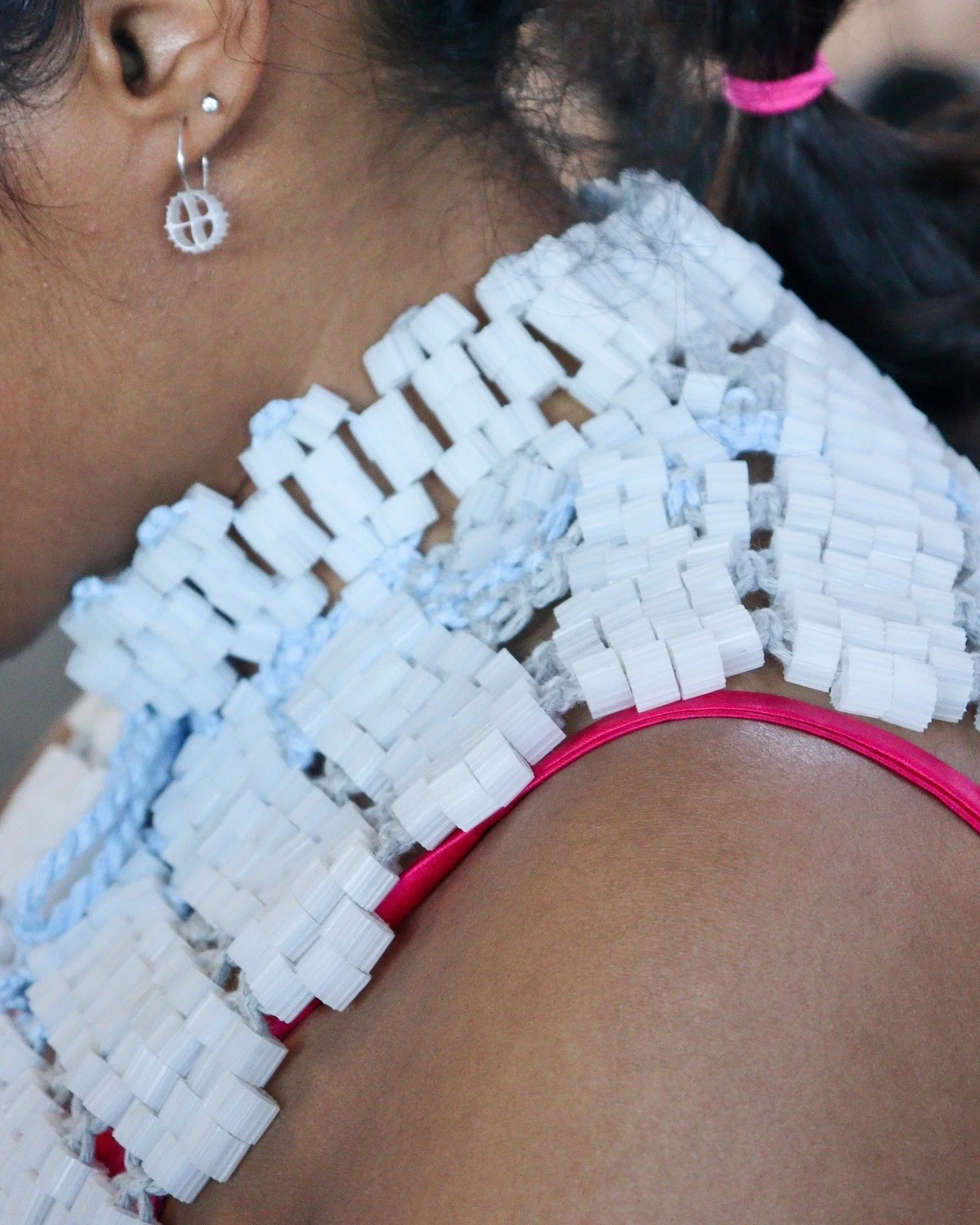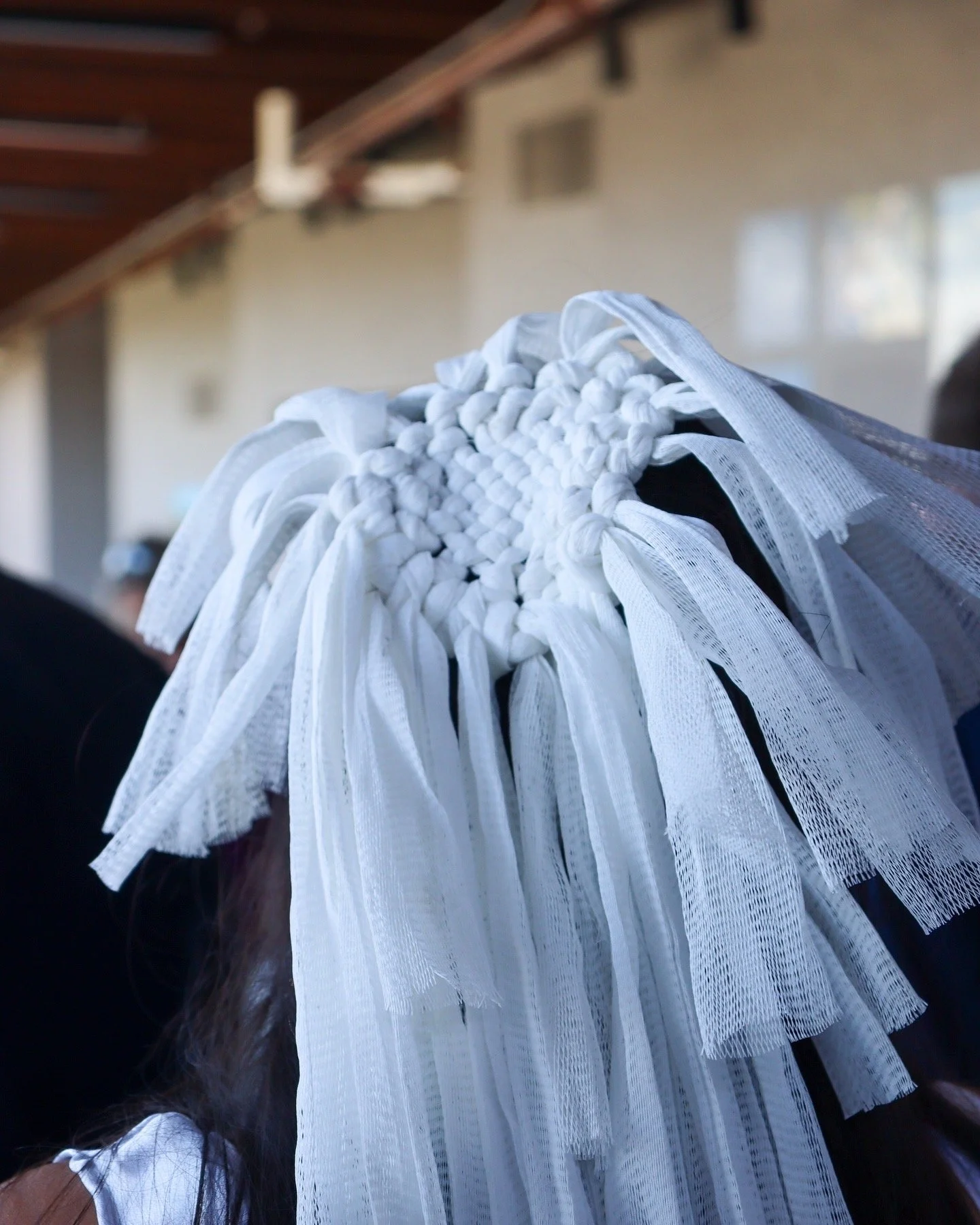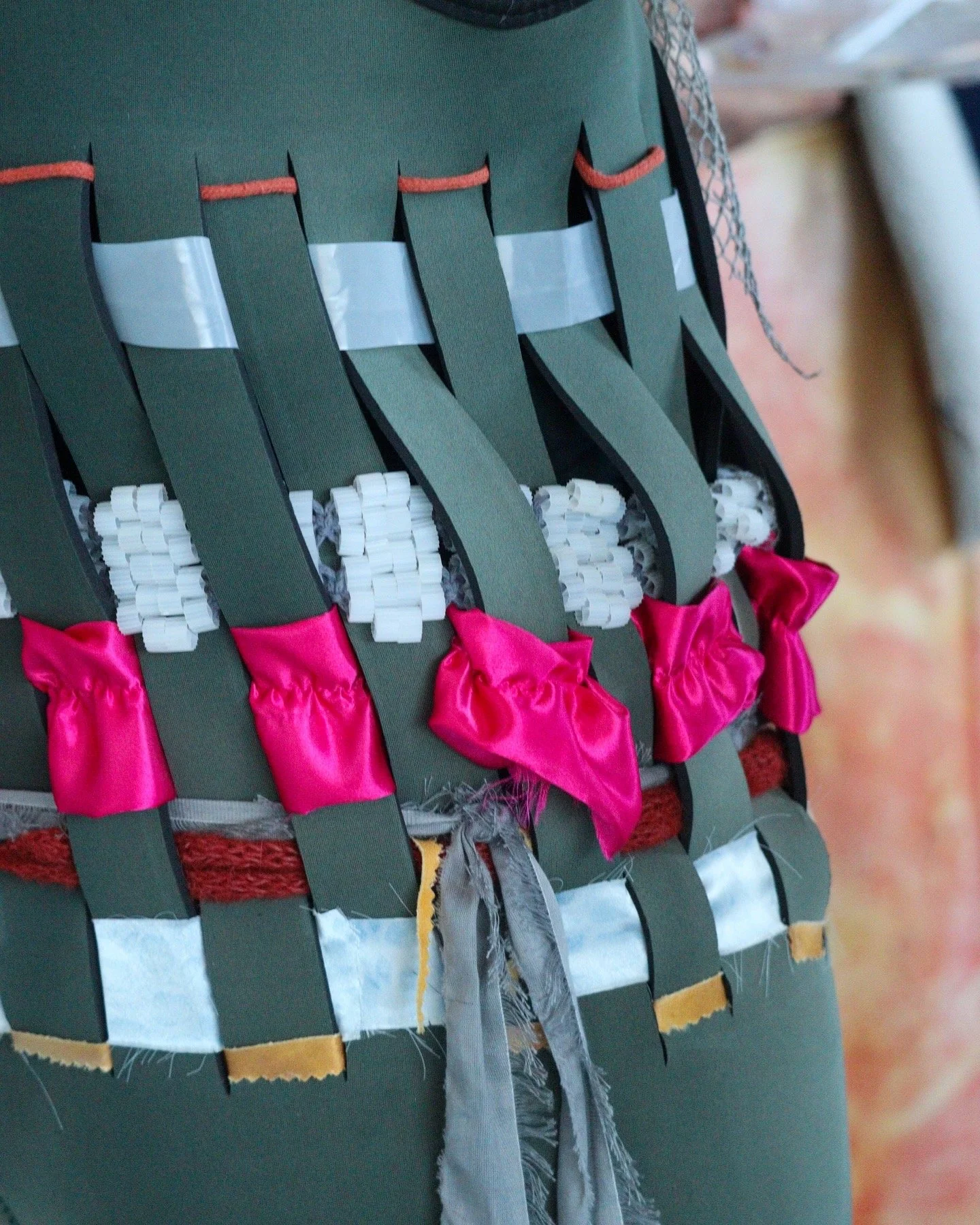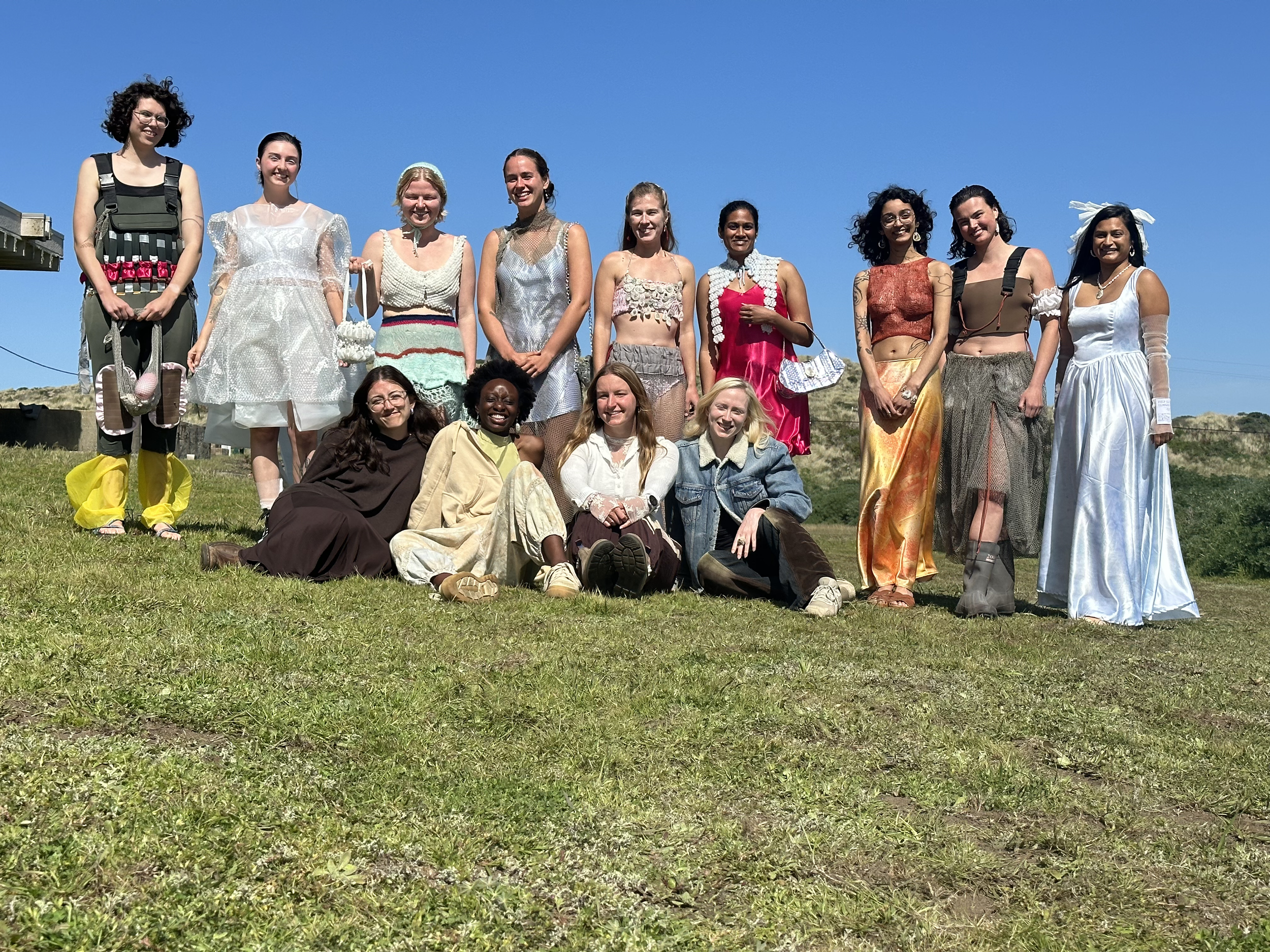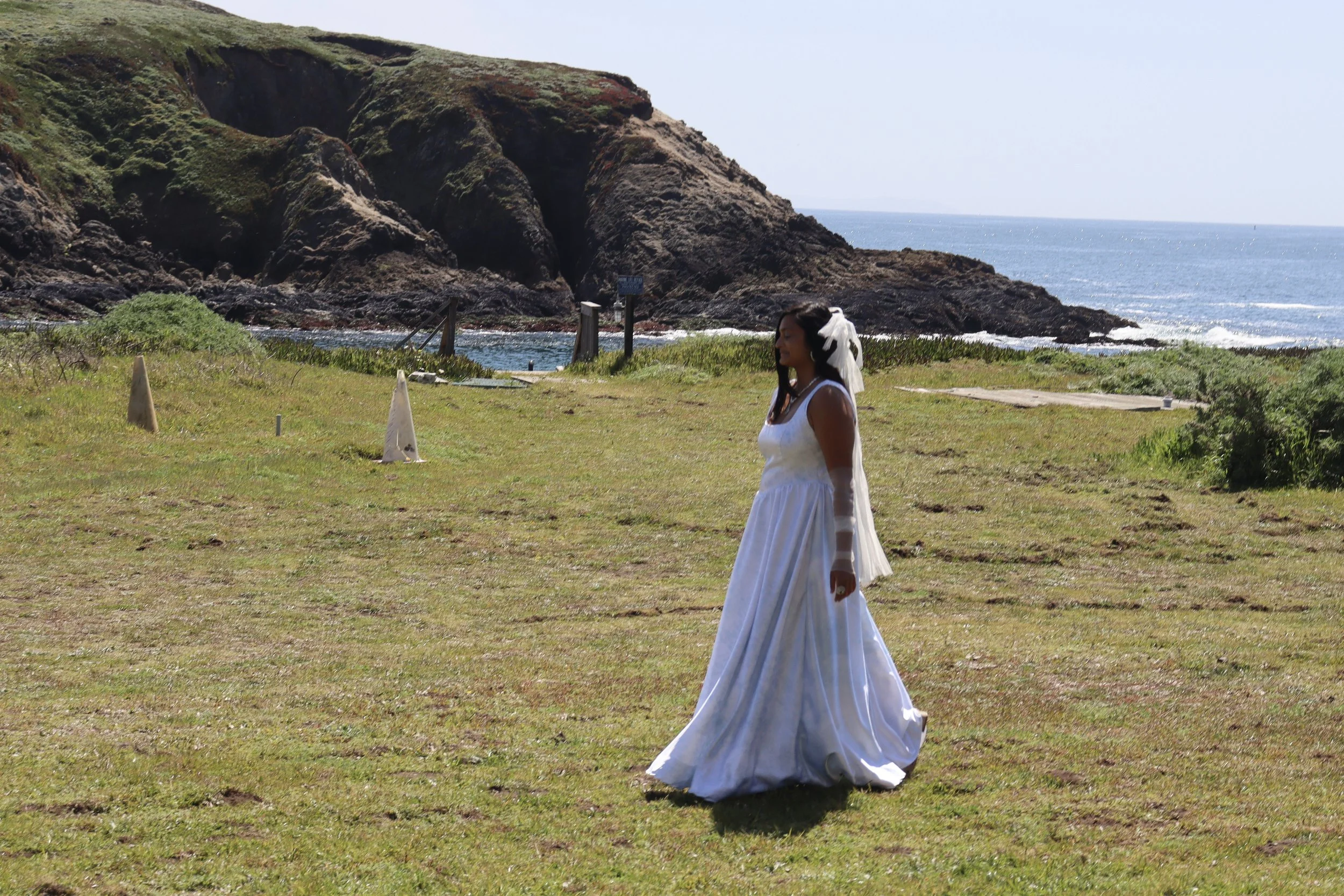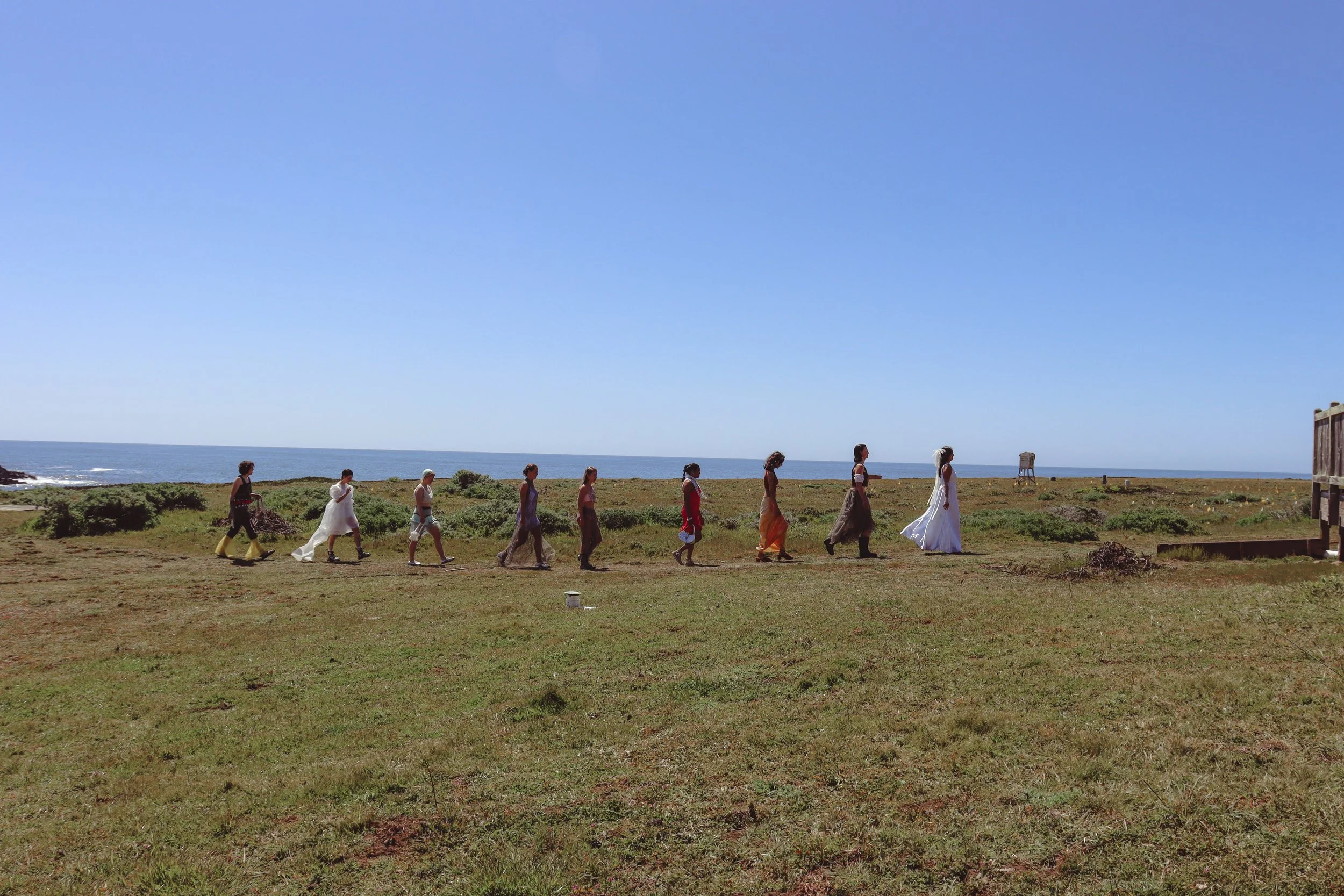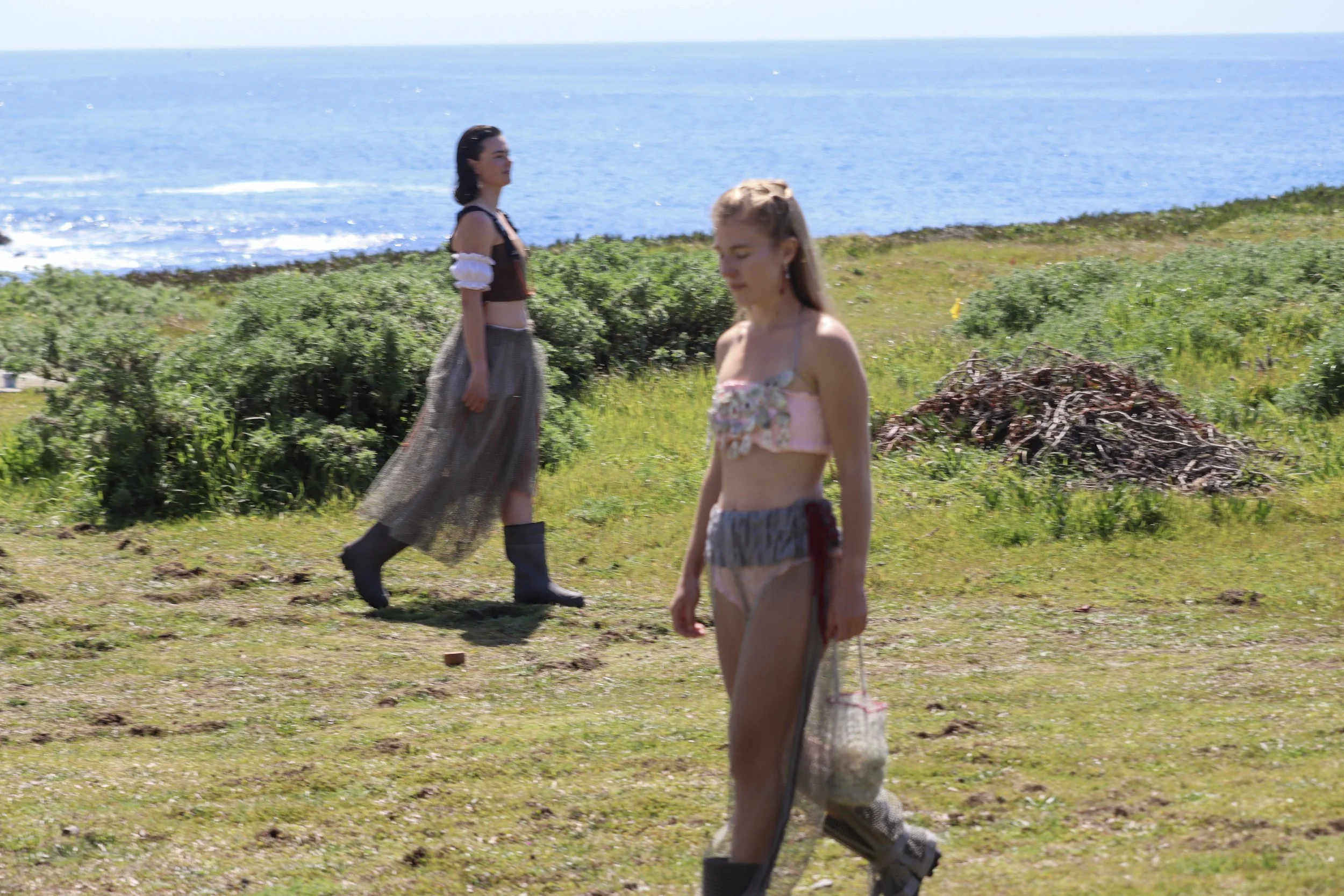exaptive potential
Exaptation is the phenomenon where a trait adapted within a species for one purpose enables an unrelated, unintended function. The adaptation of feathers in birds was to regulate heat. Those feathers were later co-opted to facilitate flight. n-girls collective finds exaptive potential for reimagined fiber and fashion in the wildlife of Bodega Bay and the California coast.
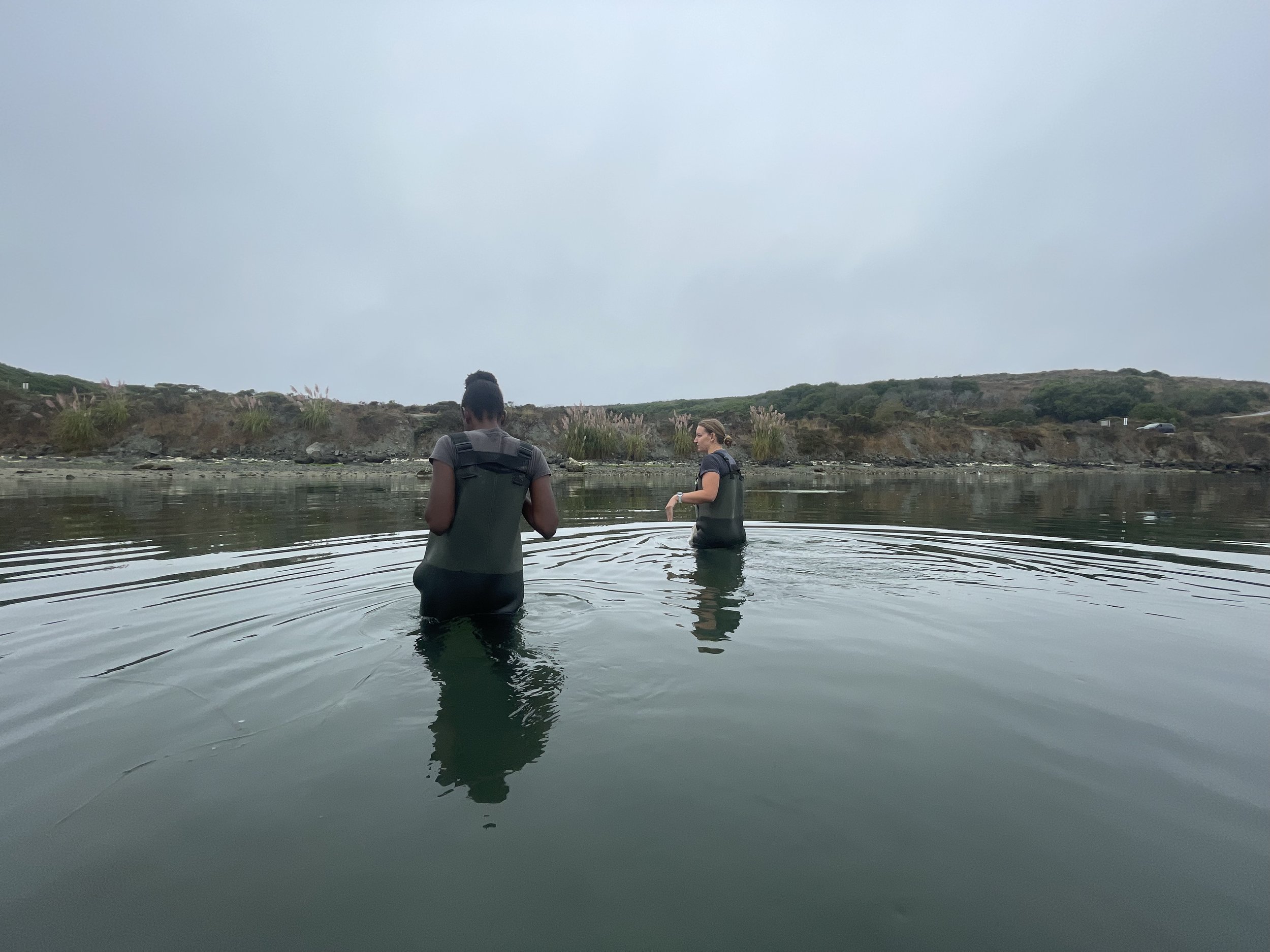
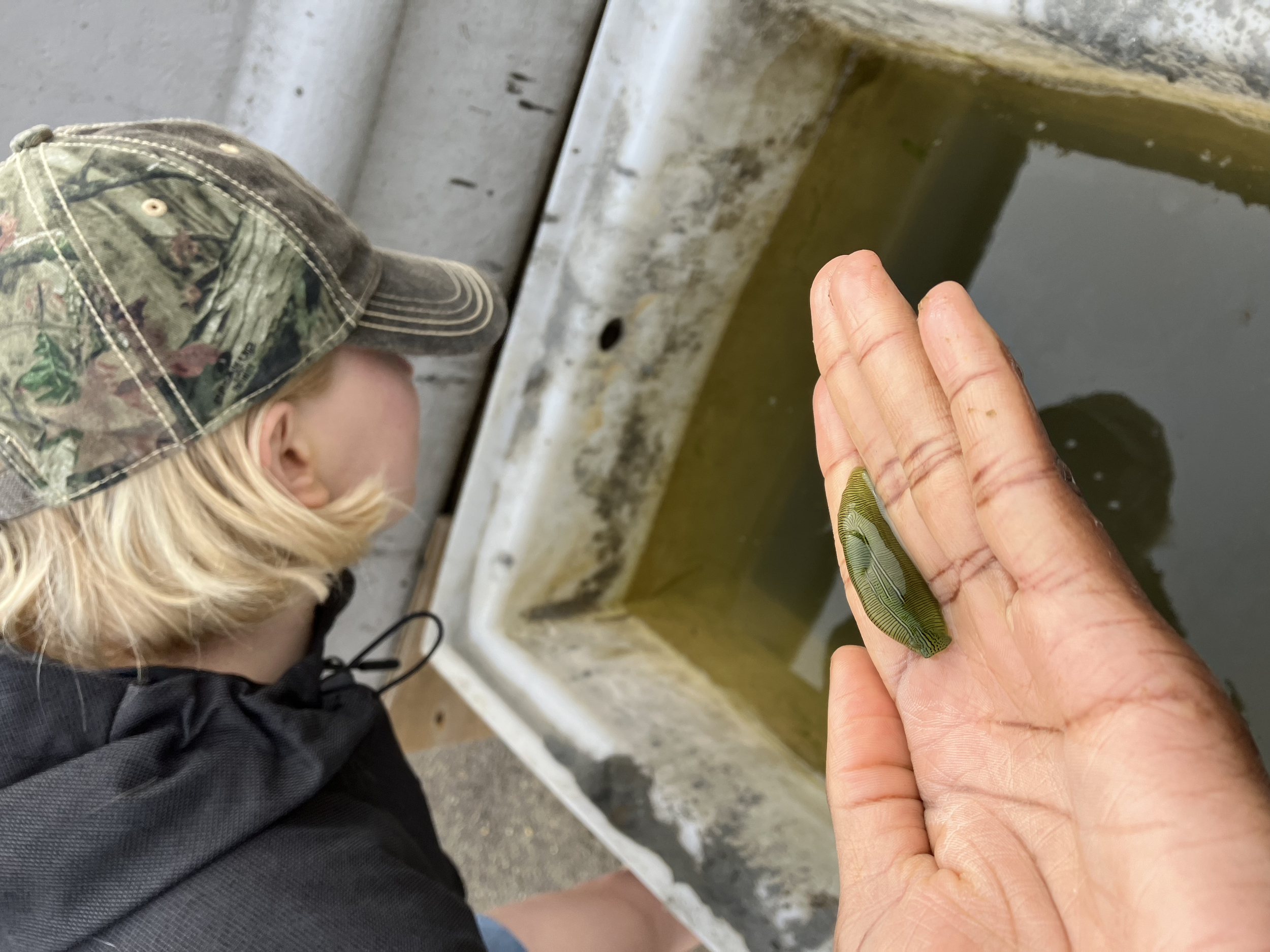
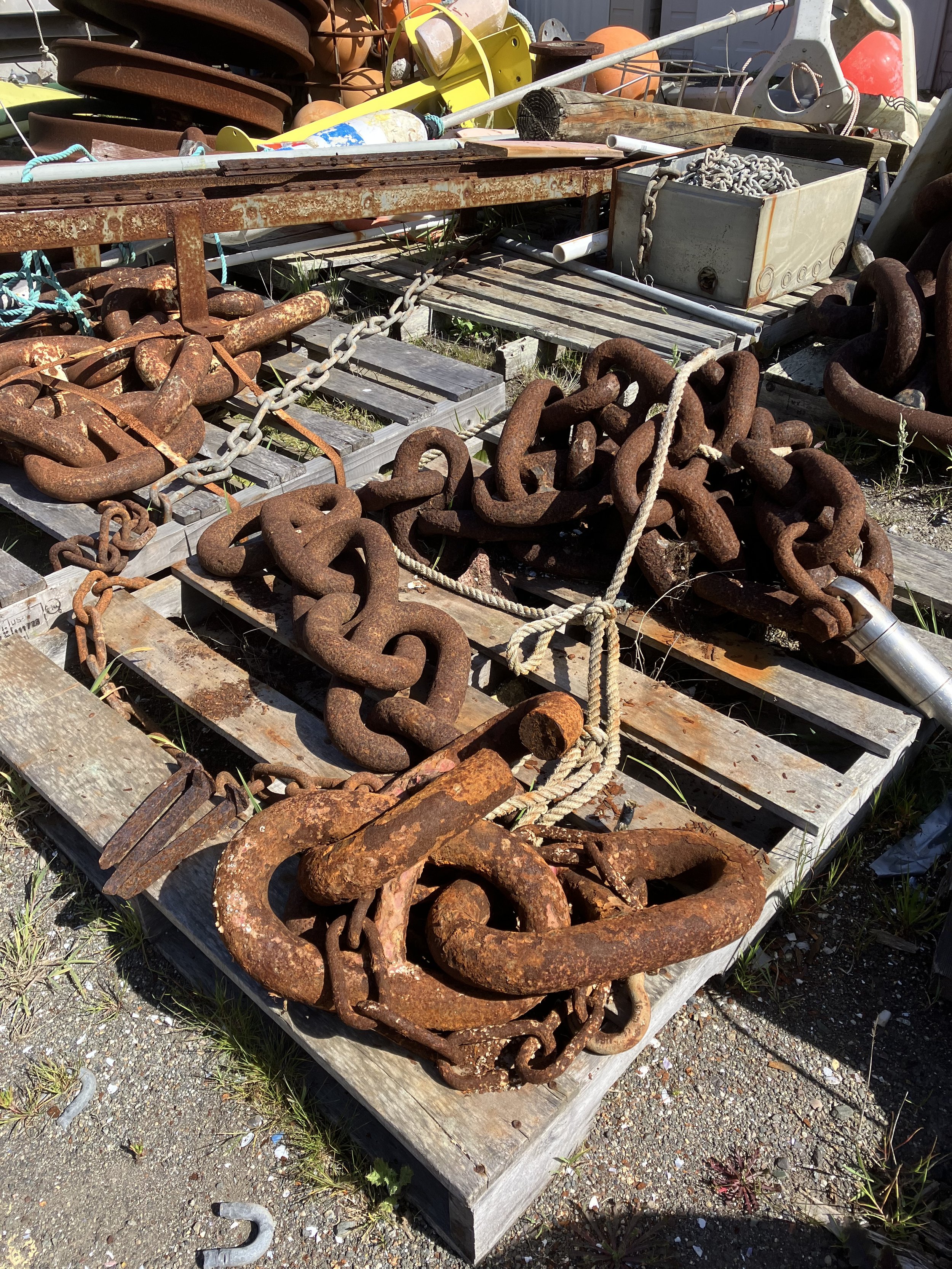

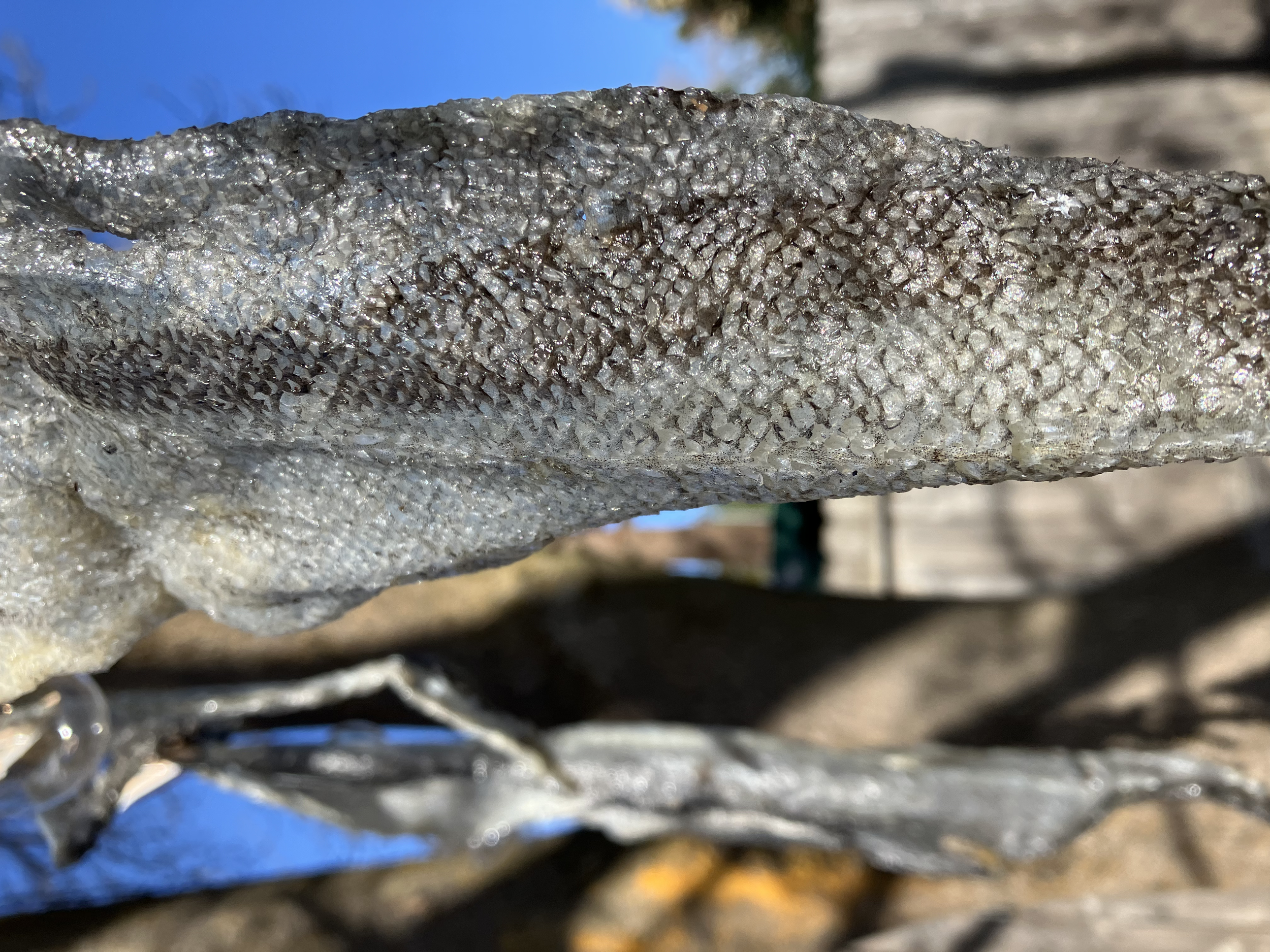
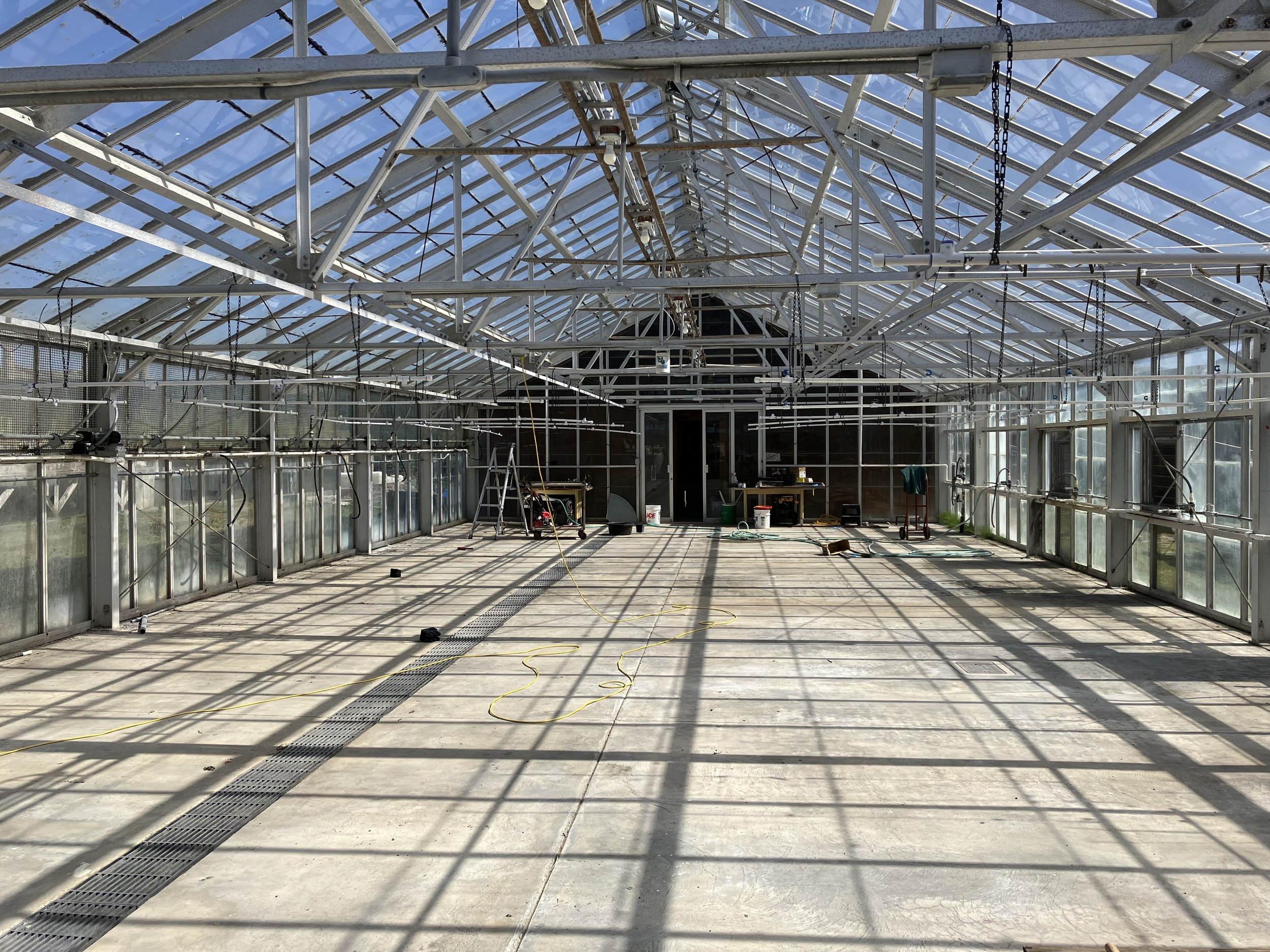

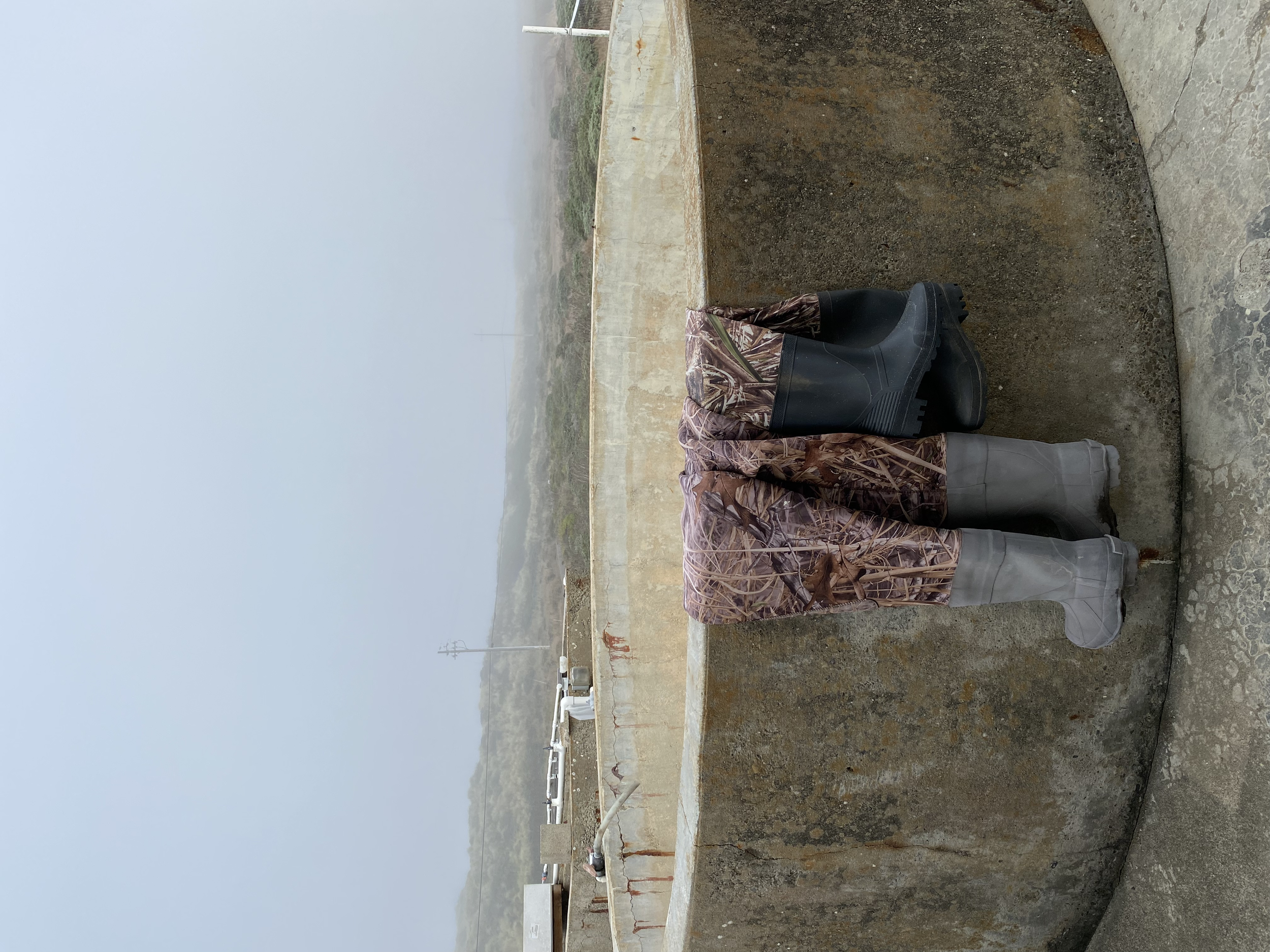

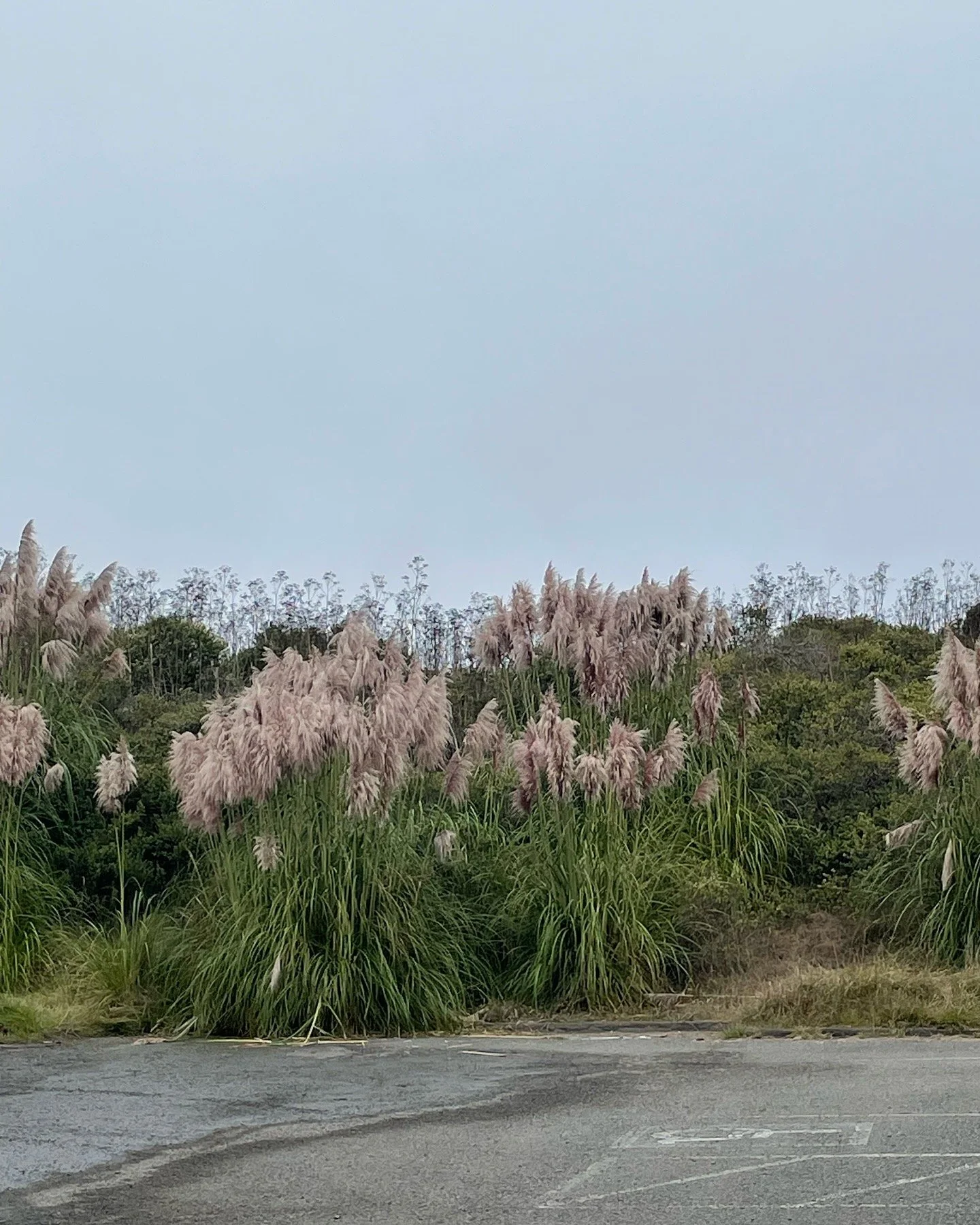
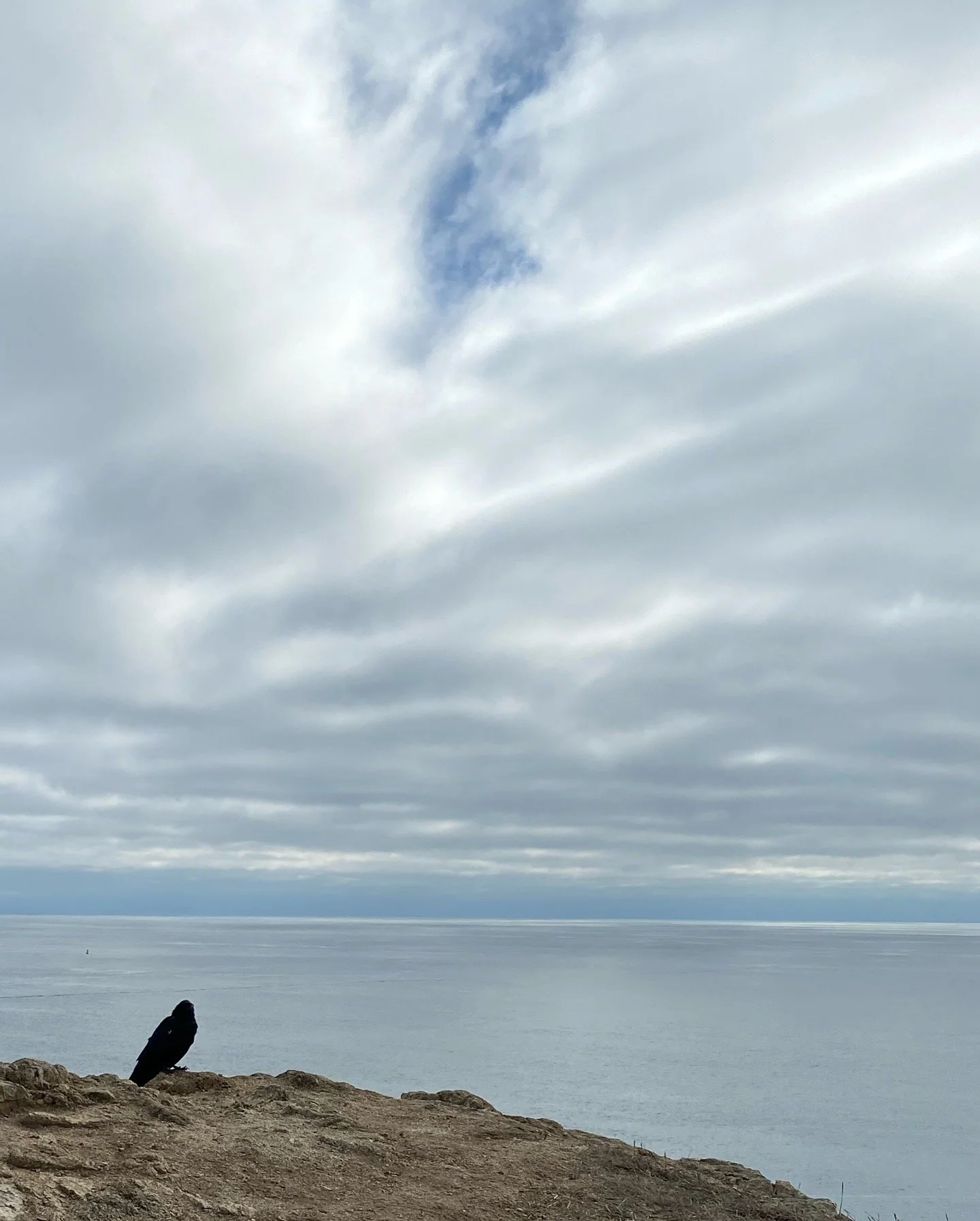
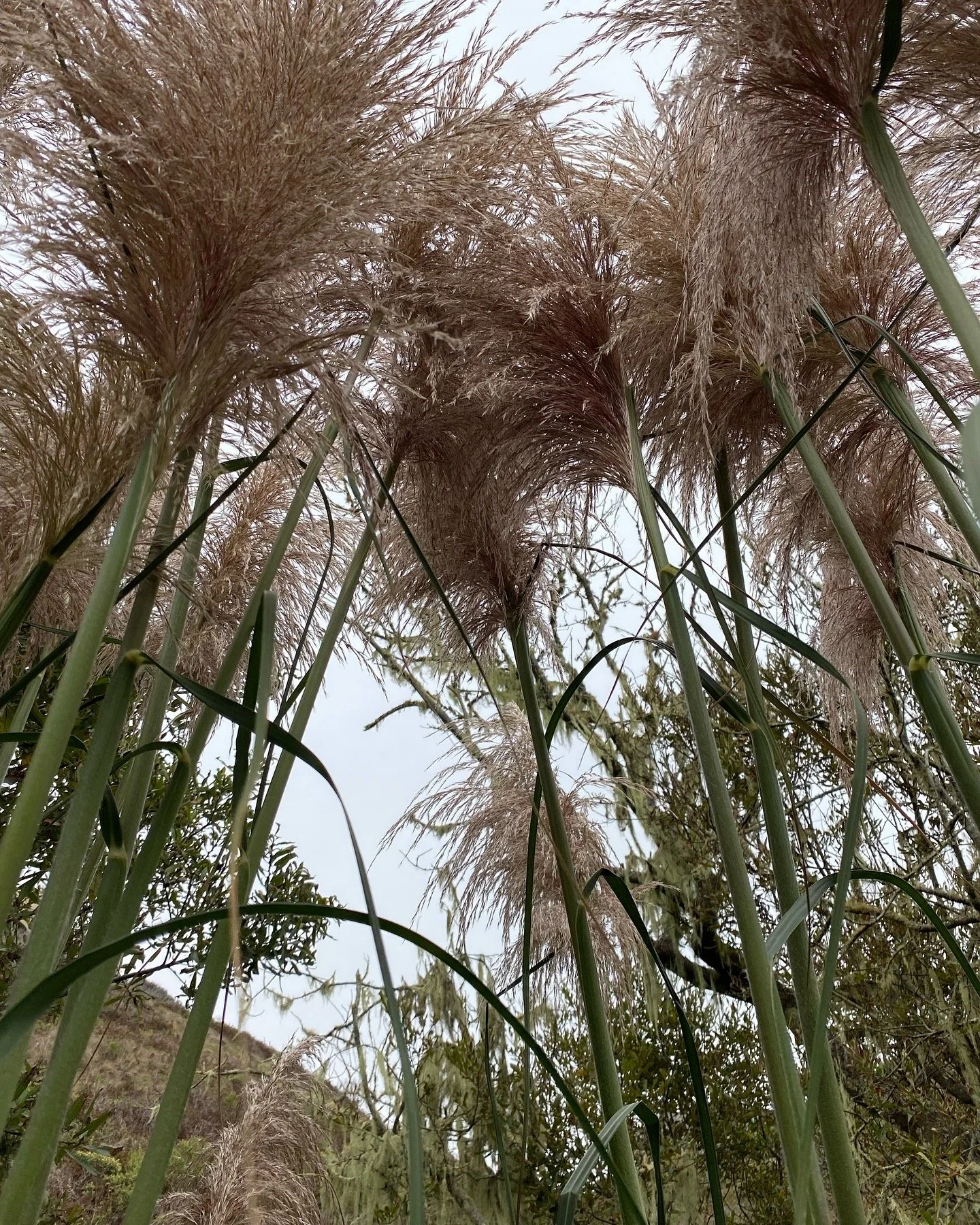


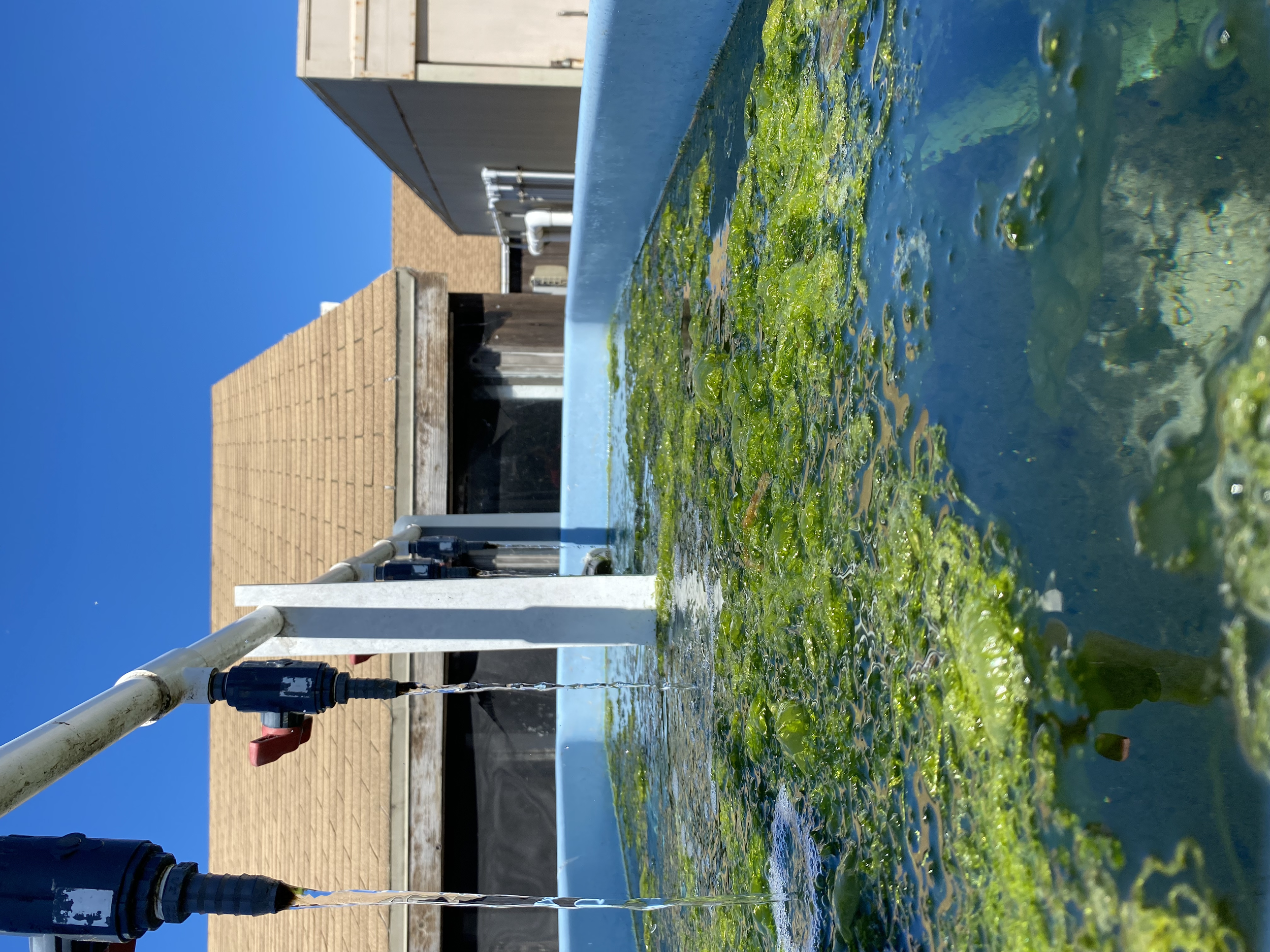
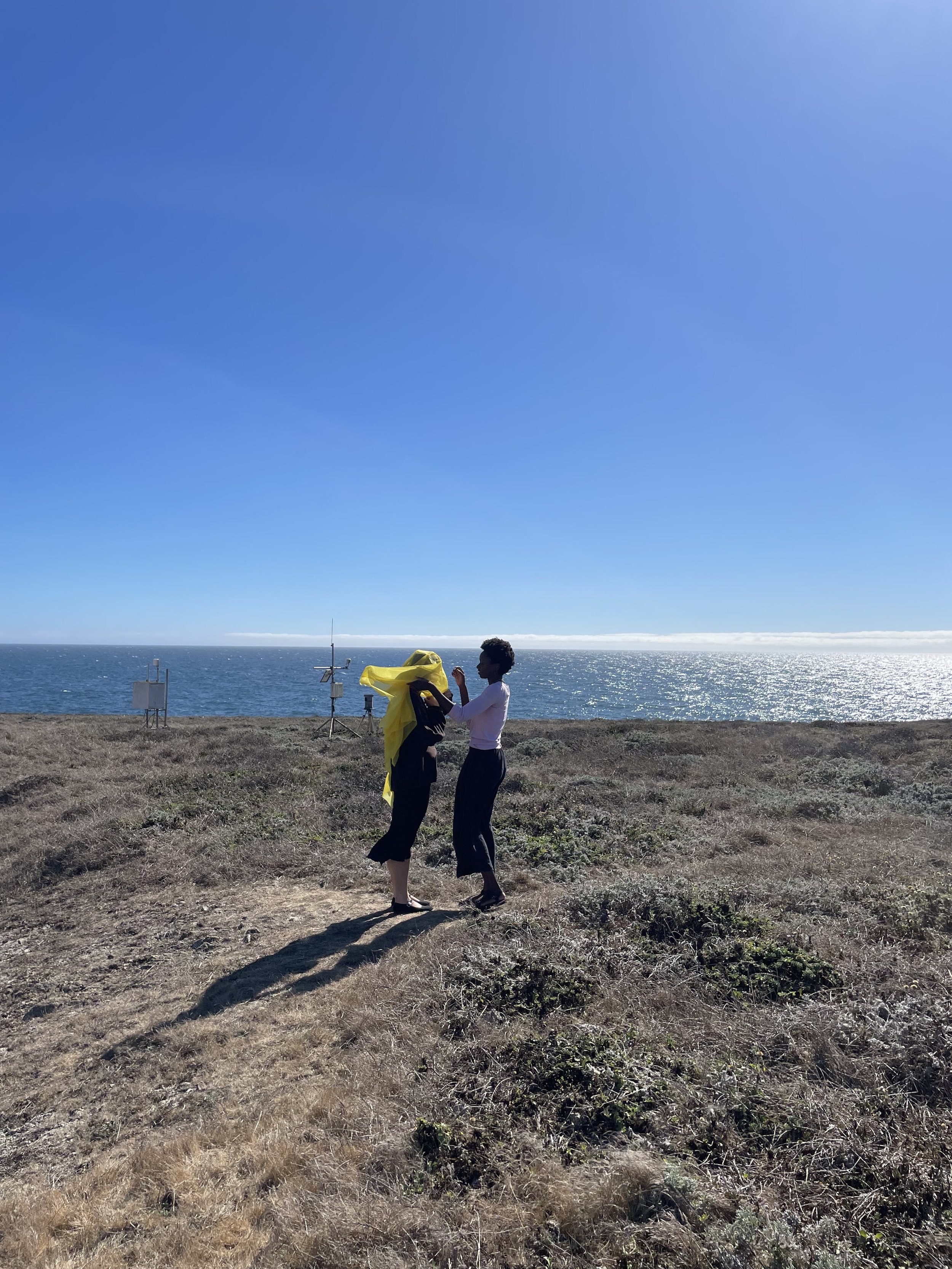
What can we take from our hyperlocal space and transform into sustainable, functional art?
What exaptive functions and forms are available to us in the abundant wildlife and waste of one place?
exaptive potential is a place-based runway collection designed and crafted by n-girls collective. Plants, algae, shells, discarded fish, and trash were responsibly foraged in and around Bodega Bay and similar biomes, or reclaimed from the Bodega Marine Laboratory and local institutions.
With them we cyanotype dyed cloth, wove waste materials into structured forms, up-cycled discarded fishing net into wearable garments, extracted agar and other stabilizing agents from algae to create bio-plastics, tanned fish leather, beaded, knotted, knit, and sewed. All garments in the collection have either some foraged or upcycled element, or are heavily inspired by Bodega Bay wildlife.
This collection was funded by the Russell J. and Dorothy S. Bilinski Fellowship grant from the University of California, Davis Bodega Marine Laboratory.

Left: Knit bonnet and agar knit skirt by Erica Goodwin, bioball beaded top by Anna Goetter, woven and knotted mesh bag by Sitoë Thiam. Right: Plastic babydoll dress by Anna Goetter, pipette earrings by . Photo by Jonathan Aguiñaga
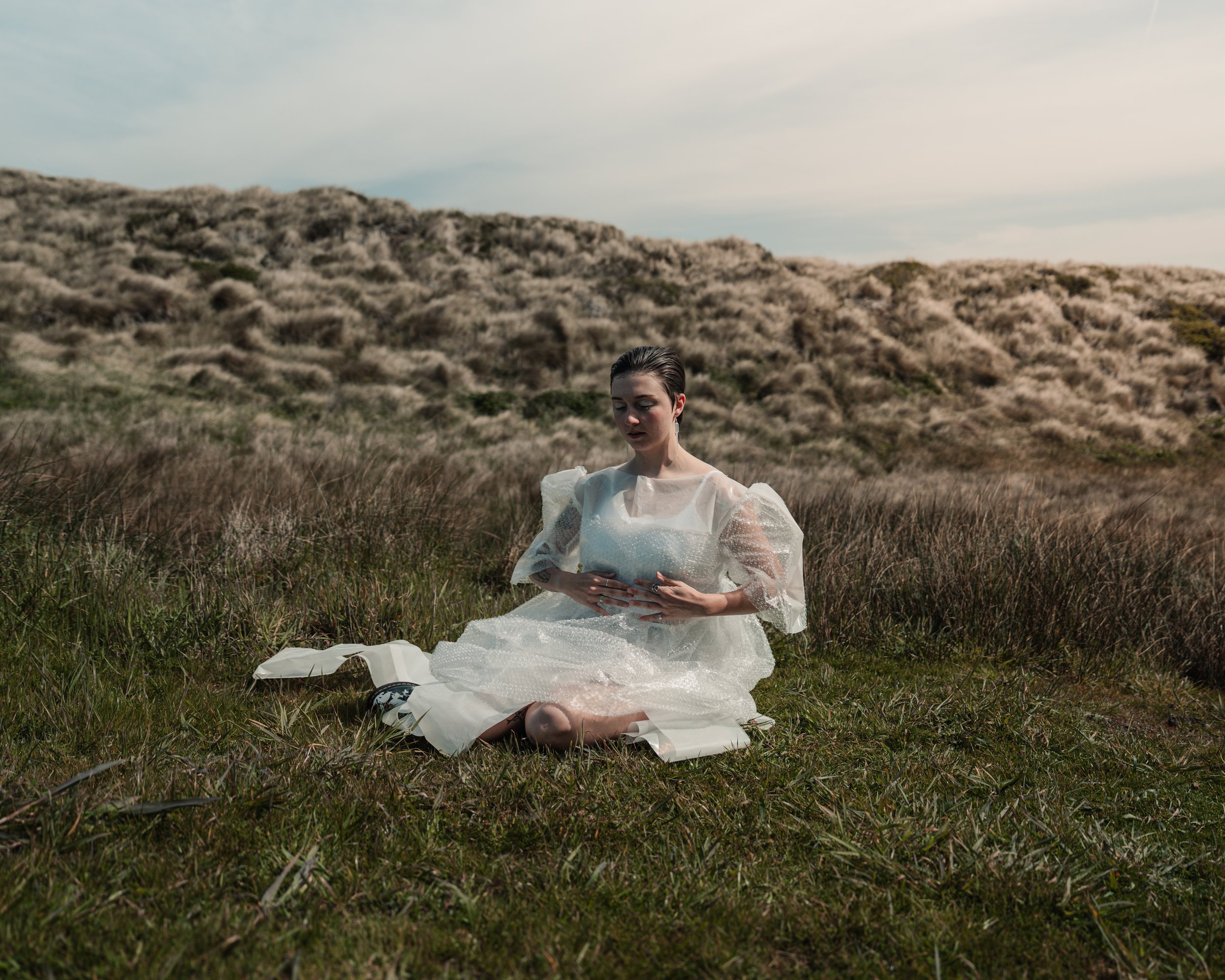
Plastic babydoll dress by Anna Goetter, pipette earrings by . Photo by Jonathan Aguiñaga

Left: Knit bonnet and agar knit skirt by Erica Goodwin, bioball beaded top by Anna Goetter, woven and knotted mesh bag by Sitoë Thiam Right: Plastic babydoll dress by Anna Goetter, pipette earrings by . Photo by Jonathan Aguiñaga
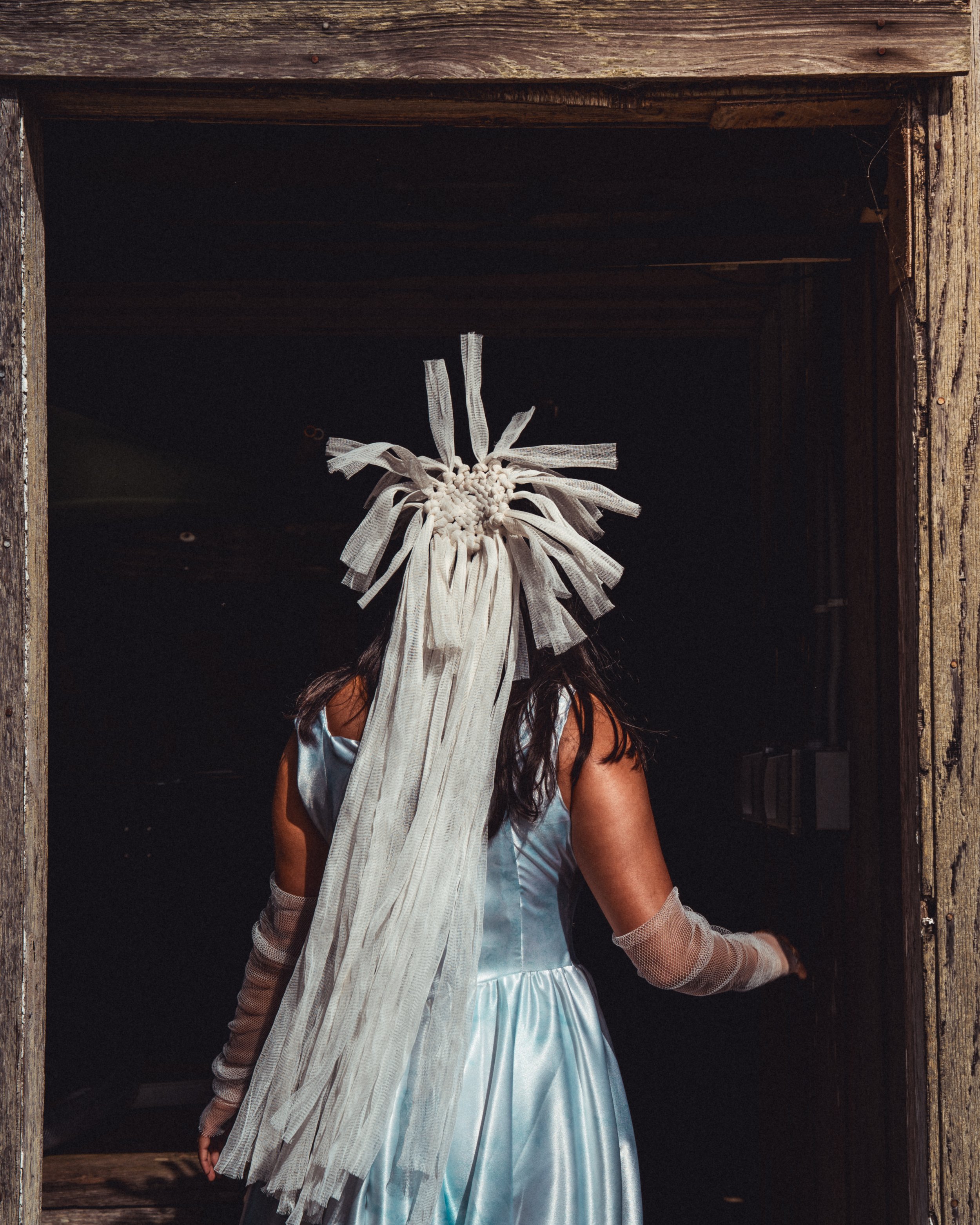
Woven mesh headpiece and gloves by Sitoë Thiam, Cyanotype printed gown by Katie Erickson. Photo by Jonathan Aguiñaga
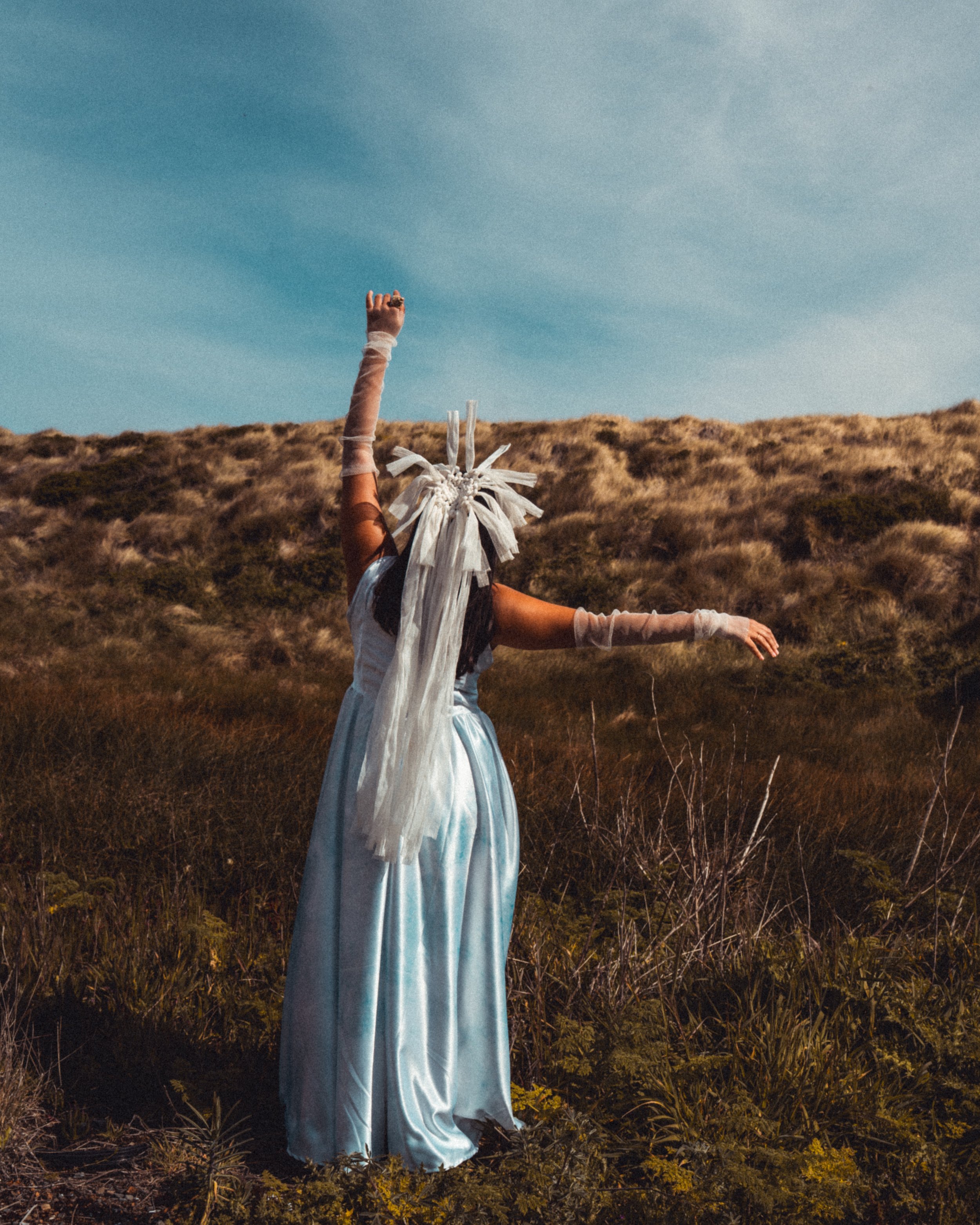
Woven mesh headpiece and gloves by Sitoë Thiam, cyanotype printed gown by Katie Erickson, barnacle ring by Anna Goetter. Photo by Jonathan Aguiñaga
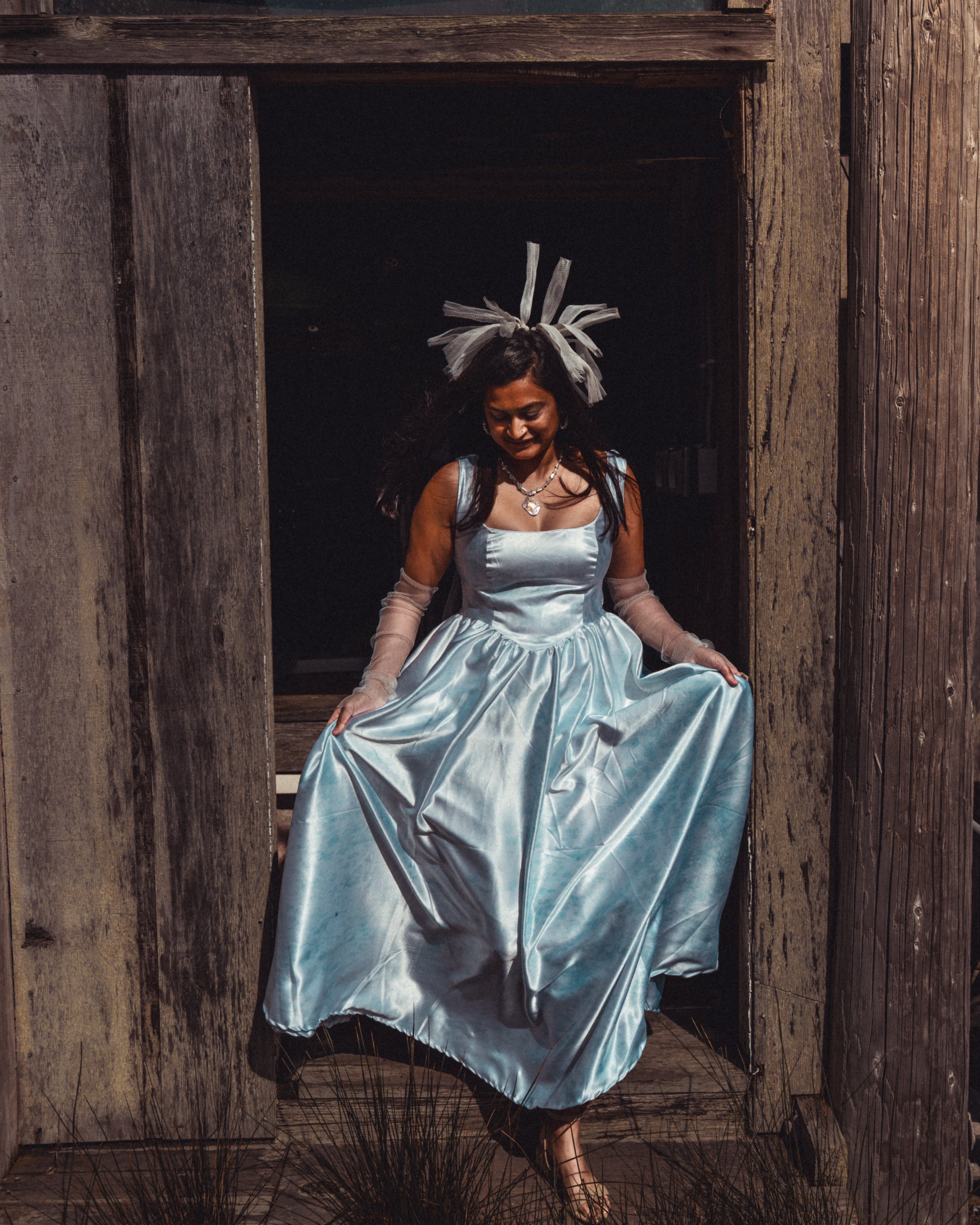
Cyanotype printed gown by Katie Erickson, pearl necklace by Erica Goodwin, pearl hoop earrings by Sitoë Thiam. Photo by Jonathan Aguiñaga
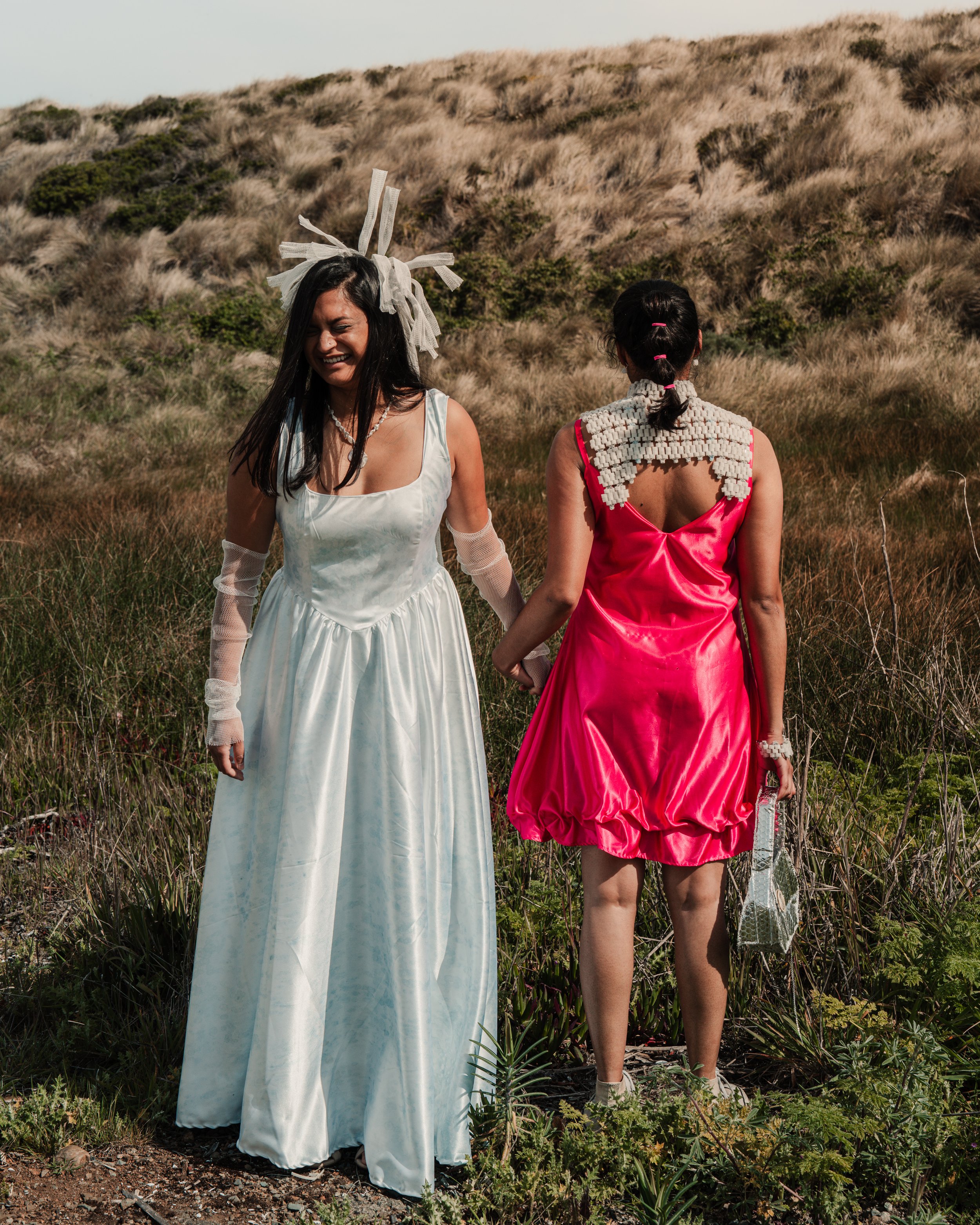
Left: Cyanotype printed gown by Katie Erickson, pearl necklace by Erica Goodwin, woven mesh headpiece and gloves by Sitoë Thiam. Right: Bioball beaded collar by Sitoë Thiam, ruffle slip dress by Katie Erickson, silver thermal shield purse by Anna Goetter. Photo by Jonathan Aguiñaga

bioball beaded collar, cuff, and earrings by Sitoë Thiam, silver thermal shield purse by Anna Goetter, ruffle slip dress by Katie Erickson. Photo by Jonathan Aguiñaga

bioball beaded collar by Sitoë Thiam, ruffle slip dress by Katie Erickson, silver thermal shield purse by Anna Goetter. Photo by Jonathan Aguiñaga
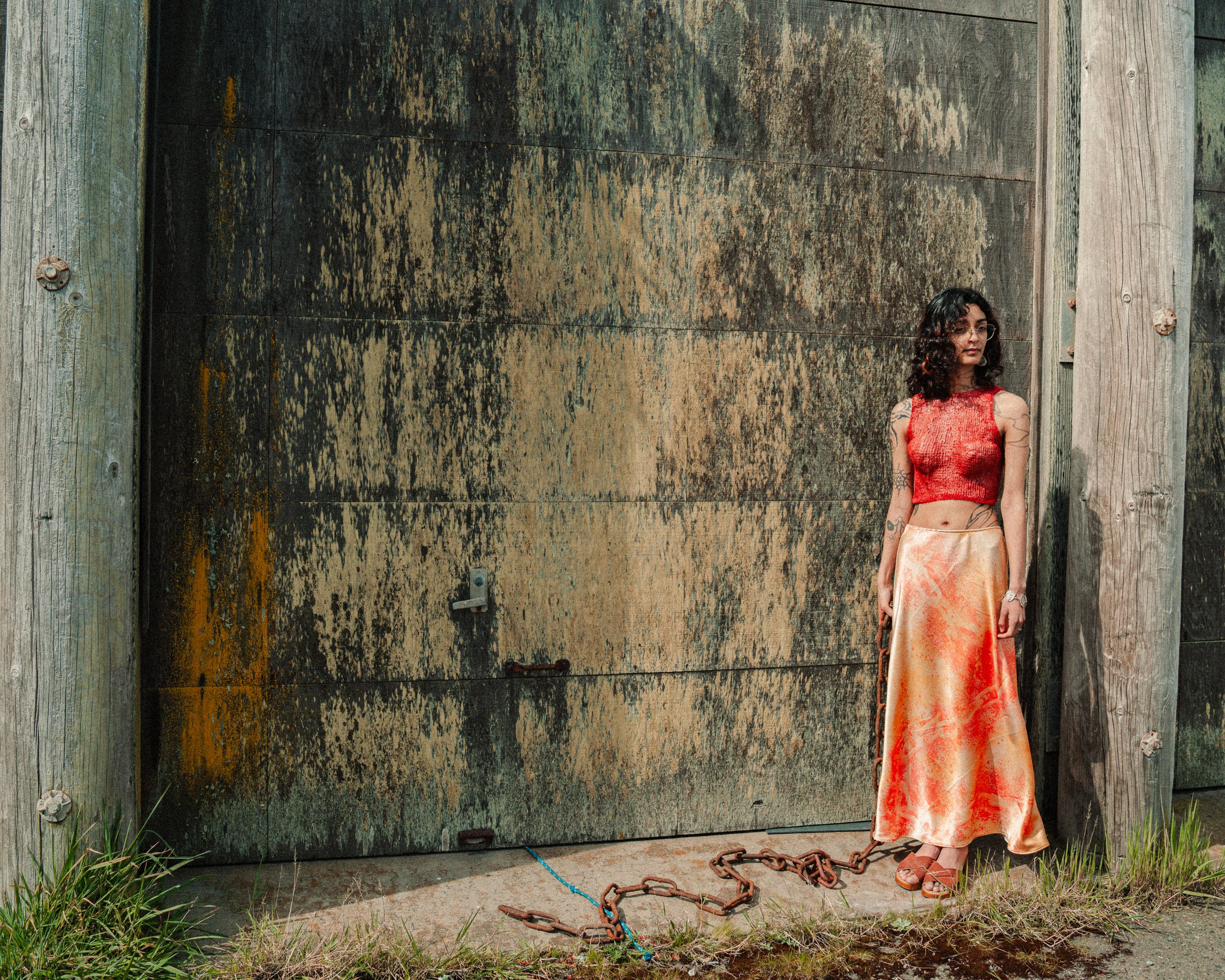
agar formed knit top by Erica Goodwin, cyanotype printed slip skirt by Katie Erickson and Erica Goodwin. Photo by Jonathan Aguiñaga
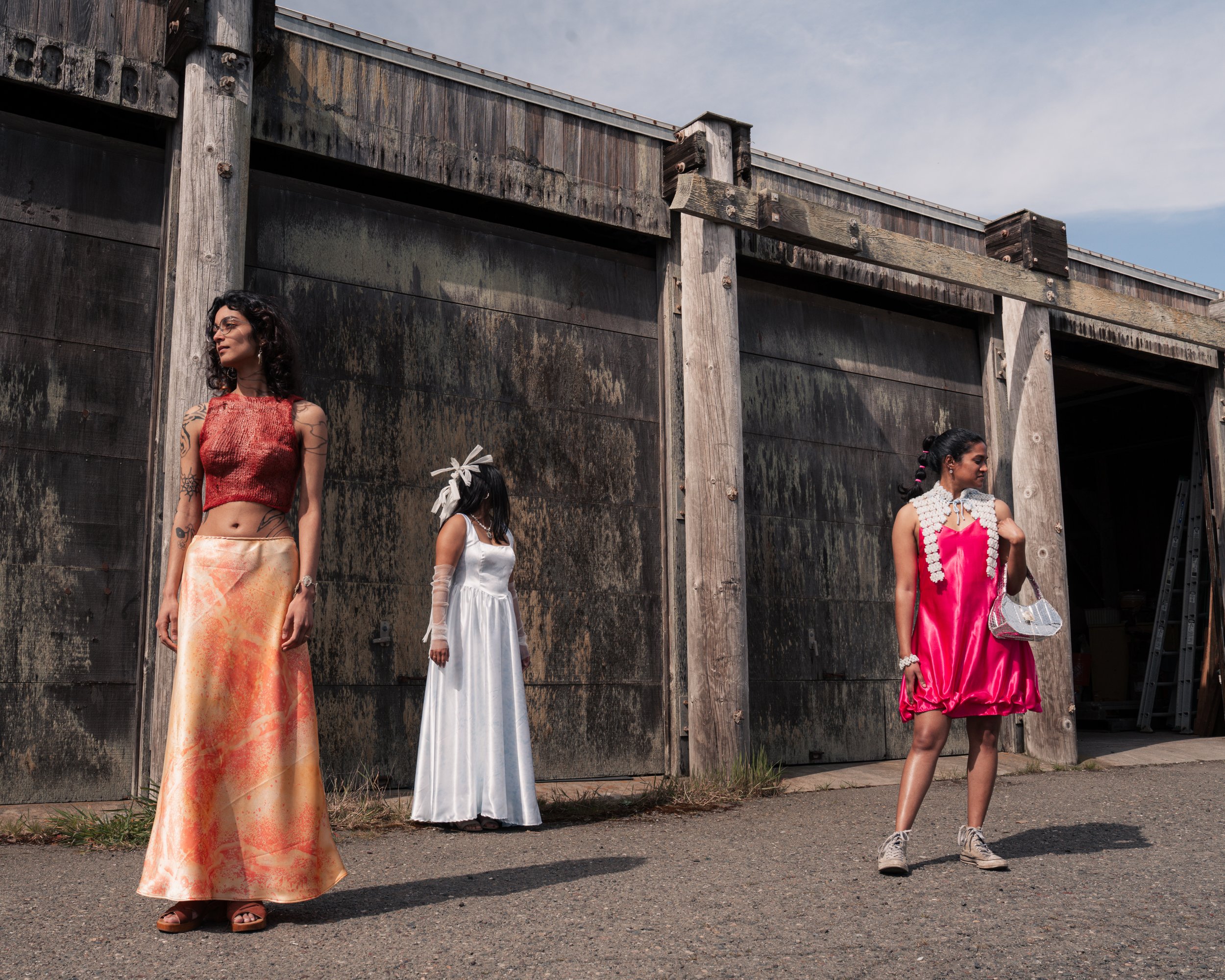
Left: Agar formed knit top by Erica Goodwin, cyanotype printed slip skirt by Katie Erickson and Erica Goodwin. Center: Cyanotype printed gown by Katie Erickson, mesh headpiece and gloves by Sitoë Thiam. Right: Bioball beaded collar, cuff, and earrings by Sitoë Thiam, ruffle slip dress by Katie Erickson, silver thermal shield purse by Anna Goetter. Photo by Jonathan Aguiñaga
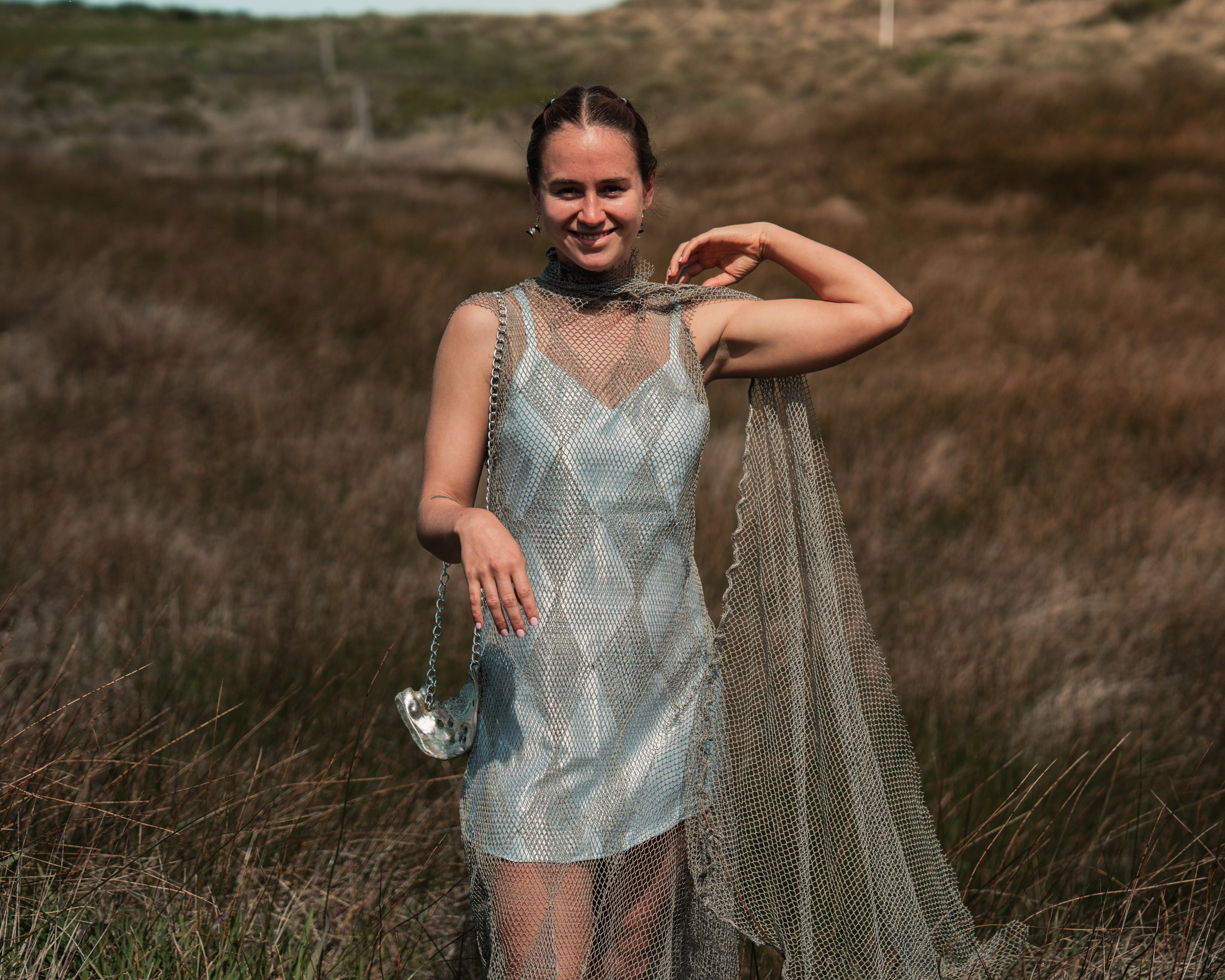
Diamond appliqué reclaimed net gown by Anna Goetter, cyanotype printed slip dress by Katie Erickson, abalone chain purse by Erica Goodwin. Photo by Jonathan Aguiñaga
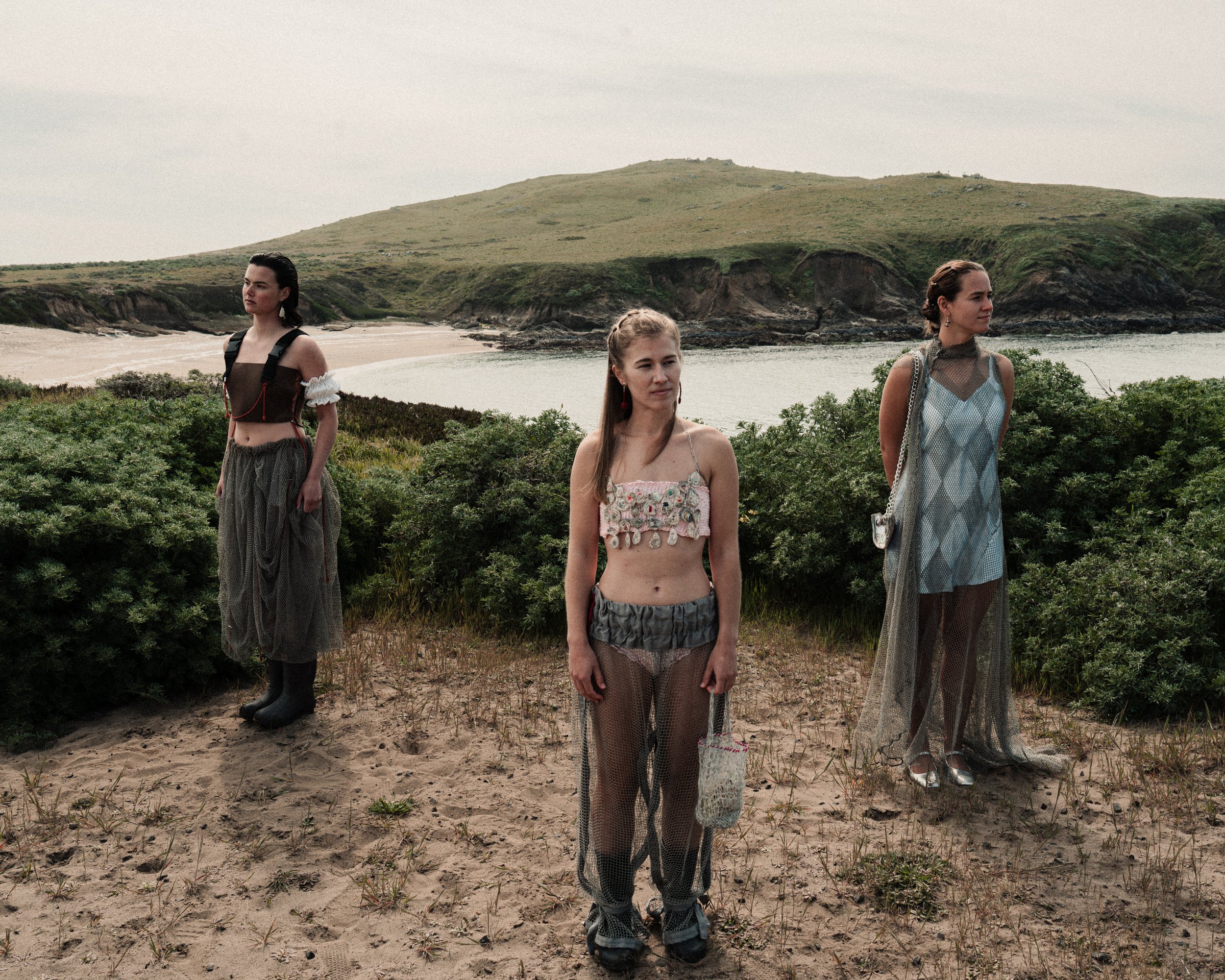
Left: Upcycled wader top by Katie Erickson and Sitoë Thiam, ruffle sleeves and bloomers by Katie Erickson, reclaimed fishing net bubble skirt by Sitoë Thiam, shell earrings by Erica Goodwin. Center: Shell chainmail top by Erica Goodwin, ruched bandeau and bikini set by Katie Erickson, ruched reclaimed net pants by Sitoë Thiam, agar knit bag by Erica Goodwin, fishing knot and pearl earrings by Sitoë Thiam. Right: Diamond appliqué reclaimed net gown by Anna Goetter, cyanotype printed slip dress by Katie Erickson, abalone chain purse by Erica Goodwin. Photo by Jonathan Aguiñaga

Shell chainmail top by Erica Goodwin, ruched bandeau and bikini set by Katie Erickson, ruched reclaimed net pants by Sitoë Thiam, agar knit bag by Erica Goodwin, fishing knot and pearl earrings by Sitoë Thiam. Photo by Jonathan Aguiñaga
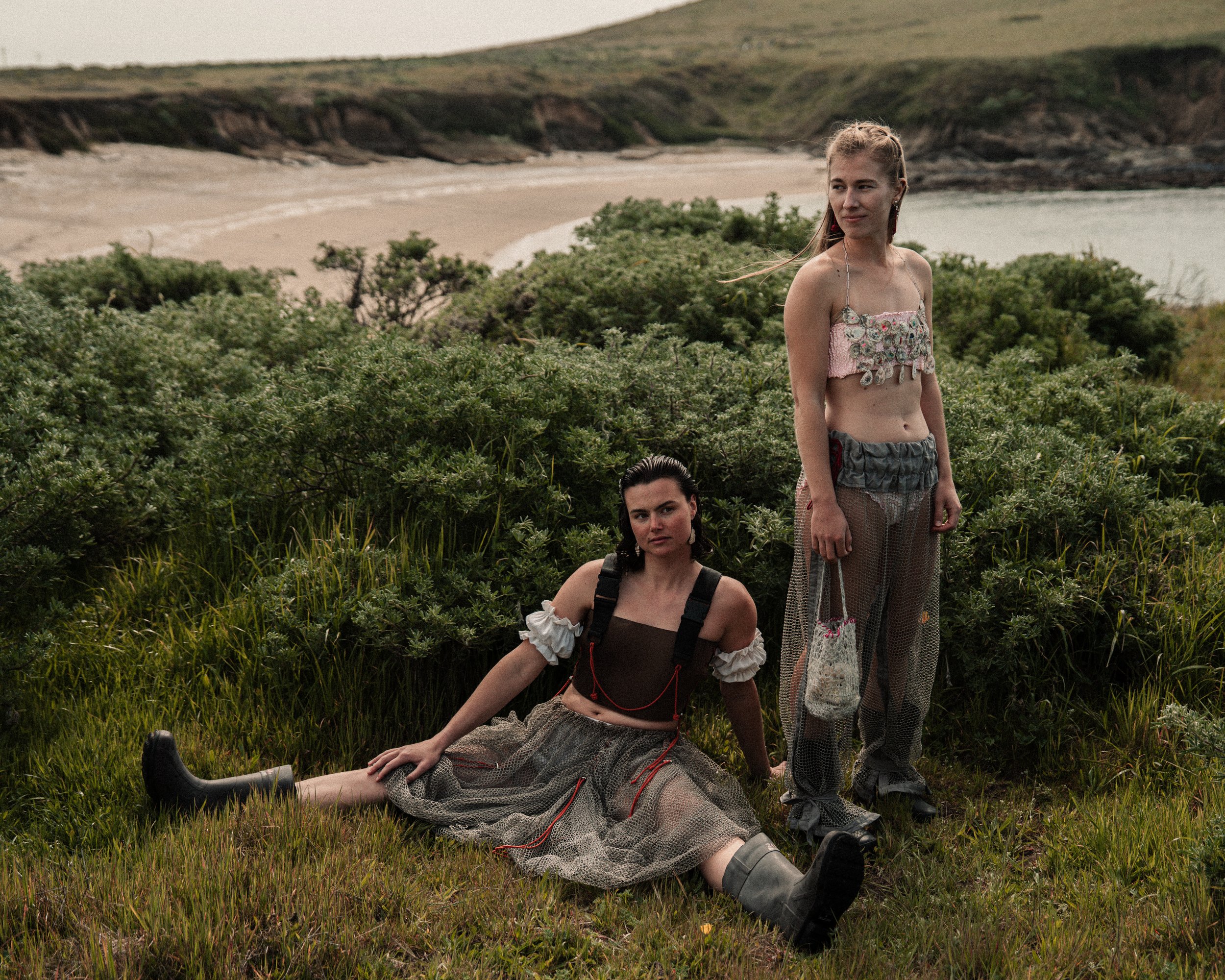
Left: Upcycled wader top by Katie Erickson and Sitoë Thiam, ruffle sleeves and bloomers by Katie Erickson, reclaimed fishing net bubble skirt by Sitoë Thiam, shell earrings by Erica Goodwin. Right: Shell chainmail top by Erica Goodwin, ruched bandeau and bikini set by Katie Erickson, ruched reclaimed net pants by Sitoë Thiam, agar knit bag by Erica Goodwin, fishing knot and pearl earrings by Sitoë Thiam. Photo by Jonathan Aguiñaga
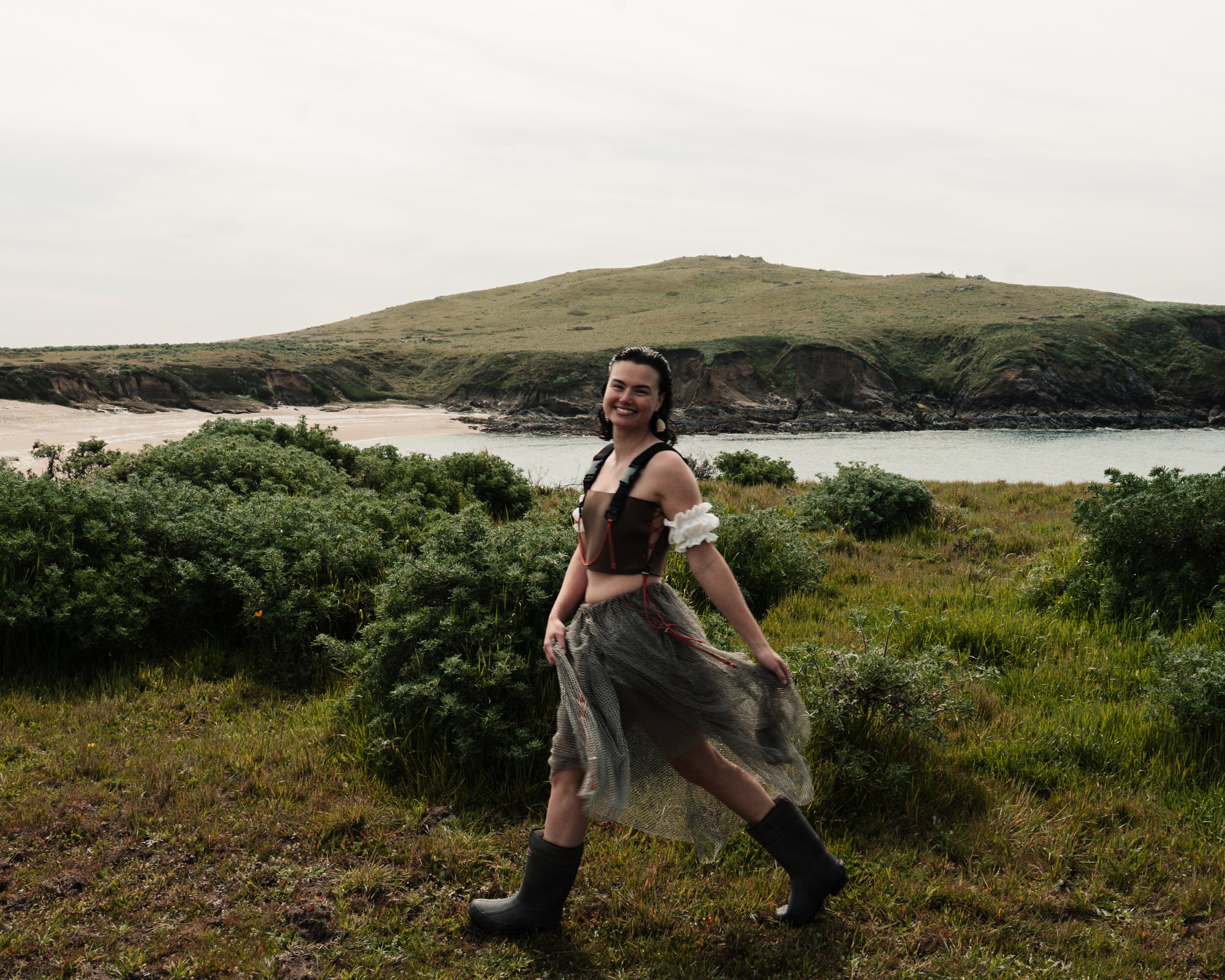
Upcycled wader top by Katie Erickson and Sitoë Thiam, ruffle sleeves and bloomers by Katie Erickson, reclaimed fishing net bubble skirt by Sitoë Thiam, shell earrings by Erica Goodwin. Photo by Jonathan Aguiñaga
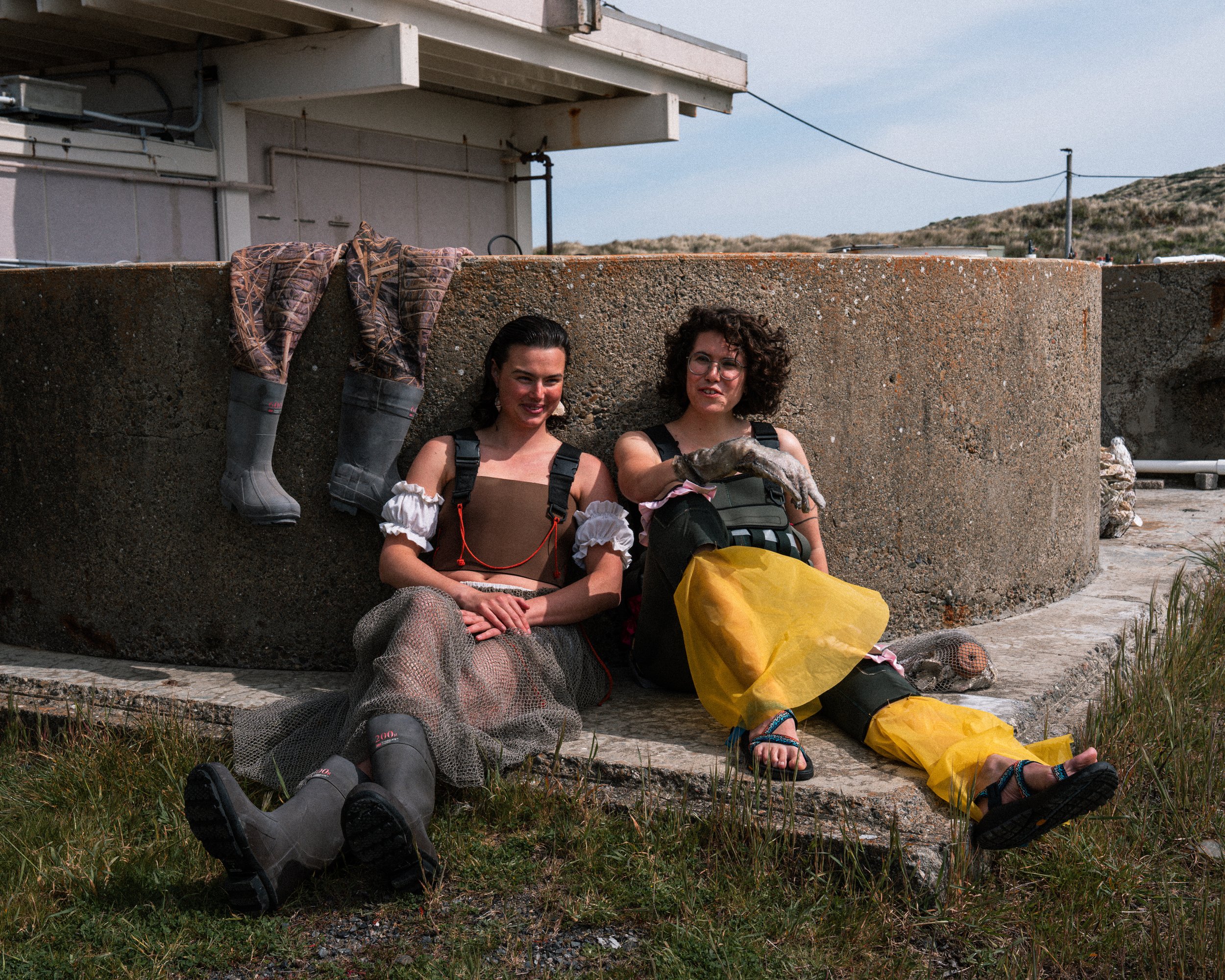
Left: Upcycled wader top by Katie Erickson and Sitoë Thiam, ruffle sleeves and bloomers by Katie Erickson, reclaimed fishing net bubble skirt by Sitoë Thiam, shell earrings by Erica Goodwin. Right: Fish leather glove by Anna Goetter, patchwork woven waders by Katie Erickson, reclaimed net tote by Sitoë Thiam. Photo by Jonathan Aguiñaga

Patchwork woven waders by Katie Erickson, reclaimed net tote by Sitoë Thiam, fish leather glove by Anna Goetter. Photo by Jonathan Aguiñaga

Knit bonnet and agar knit skirt by Erica Goodwin, bioball beaded top by Anna Goetter, knotted mesh bag and bonnet charms by Sitoë Thiam. Photo by Jonathan Aguiñaga
“this was a practice in being hopeful... Maybe species can't adapt to our rapidly changing environments, but there could still be another path to survival.”
— Katie Erickson of n-girls, quoted by Jessica Lee in Art and Ecology Merge on the Coast
n-girls collective
In the world of math and computer science, the n variable is the size of the input used to complete a function. n-girls collective keeps our collaborator number variable. We are women and queer artists entrenched in the world of STEM. For this project, our group holds four (n=4). Our work is informed by the methodologies used in our areas of study, as well as by critiques on how STEM can and has detrimentally impacted our society.
We are hopeful of new technologies, wary of how these technologies can be used, and are deferential to the old and analog technologies of our foremothers.


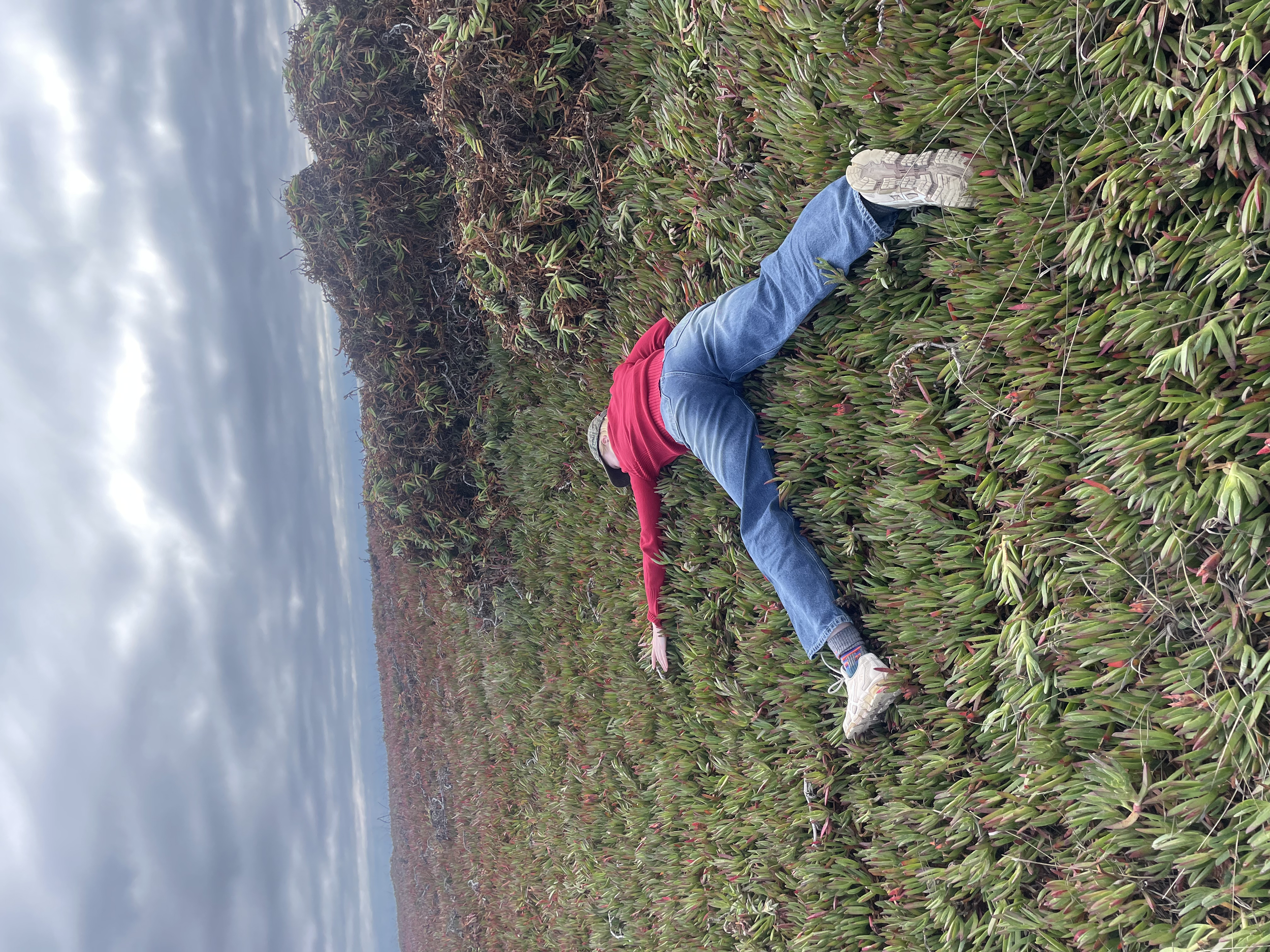
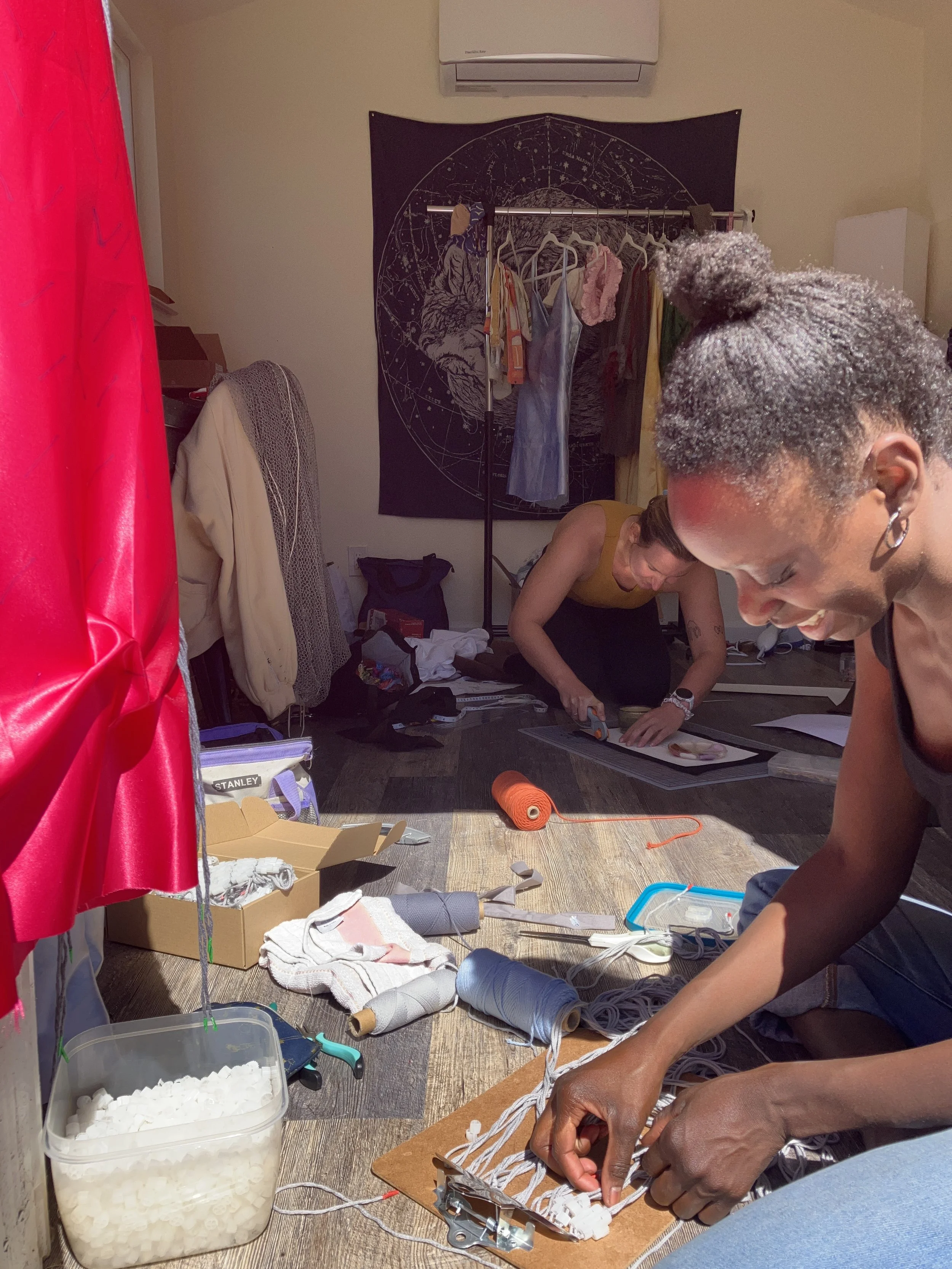
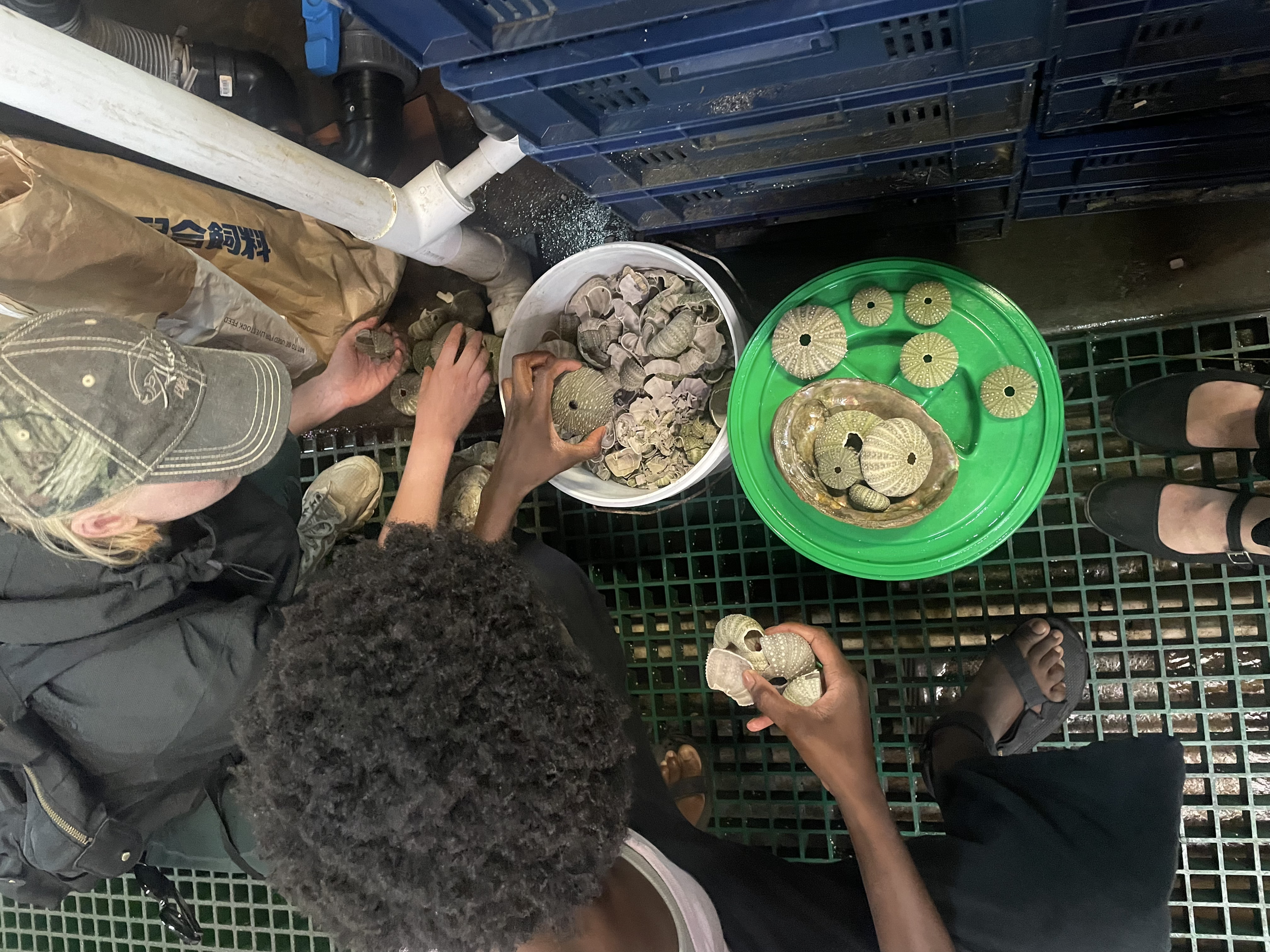
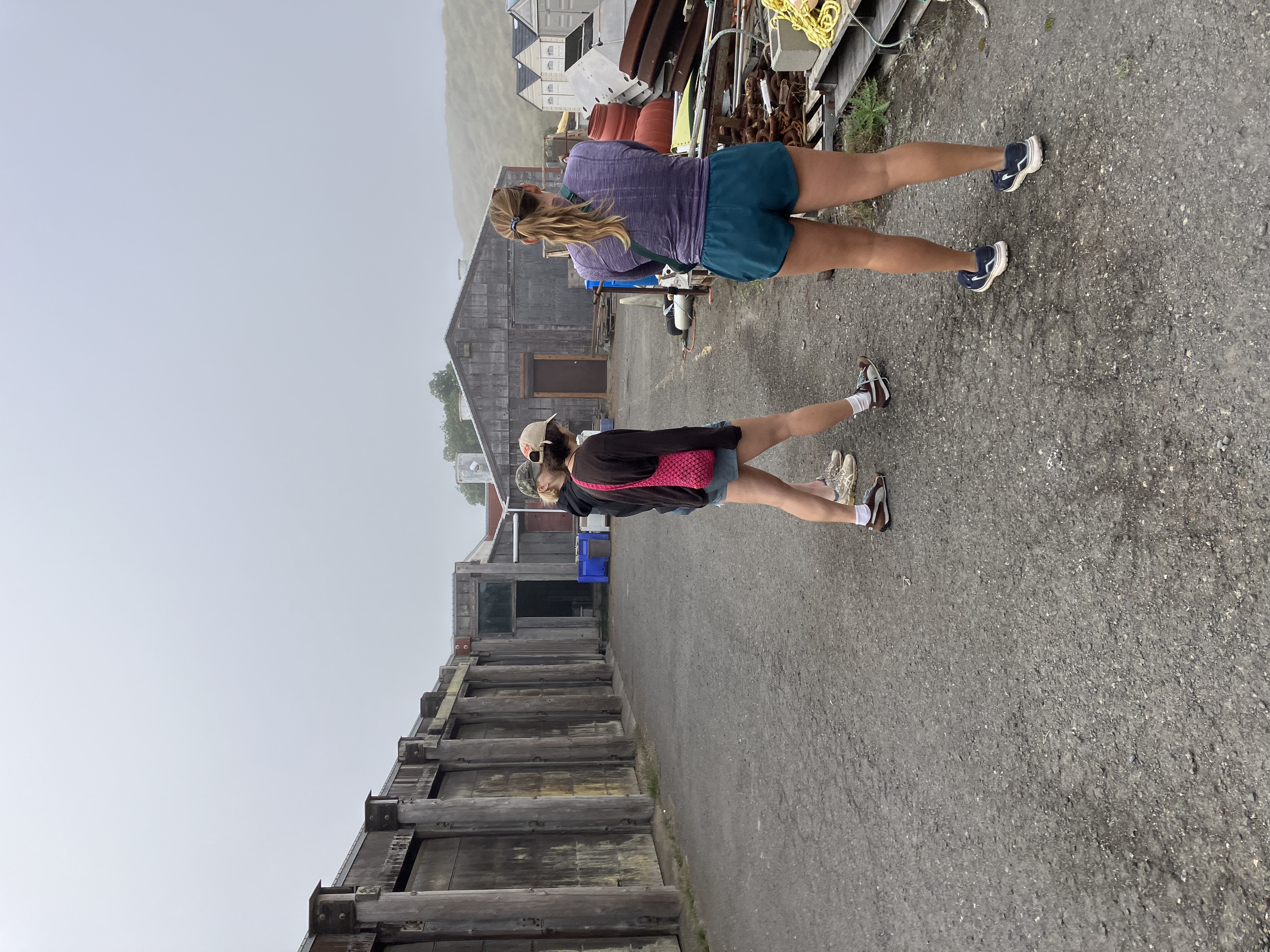
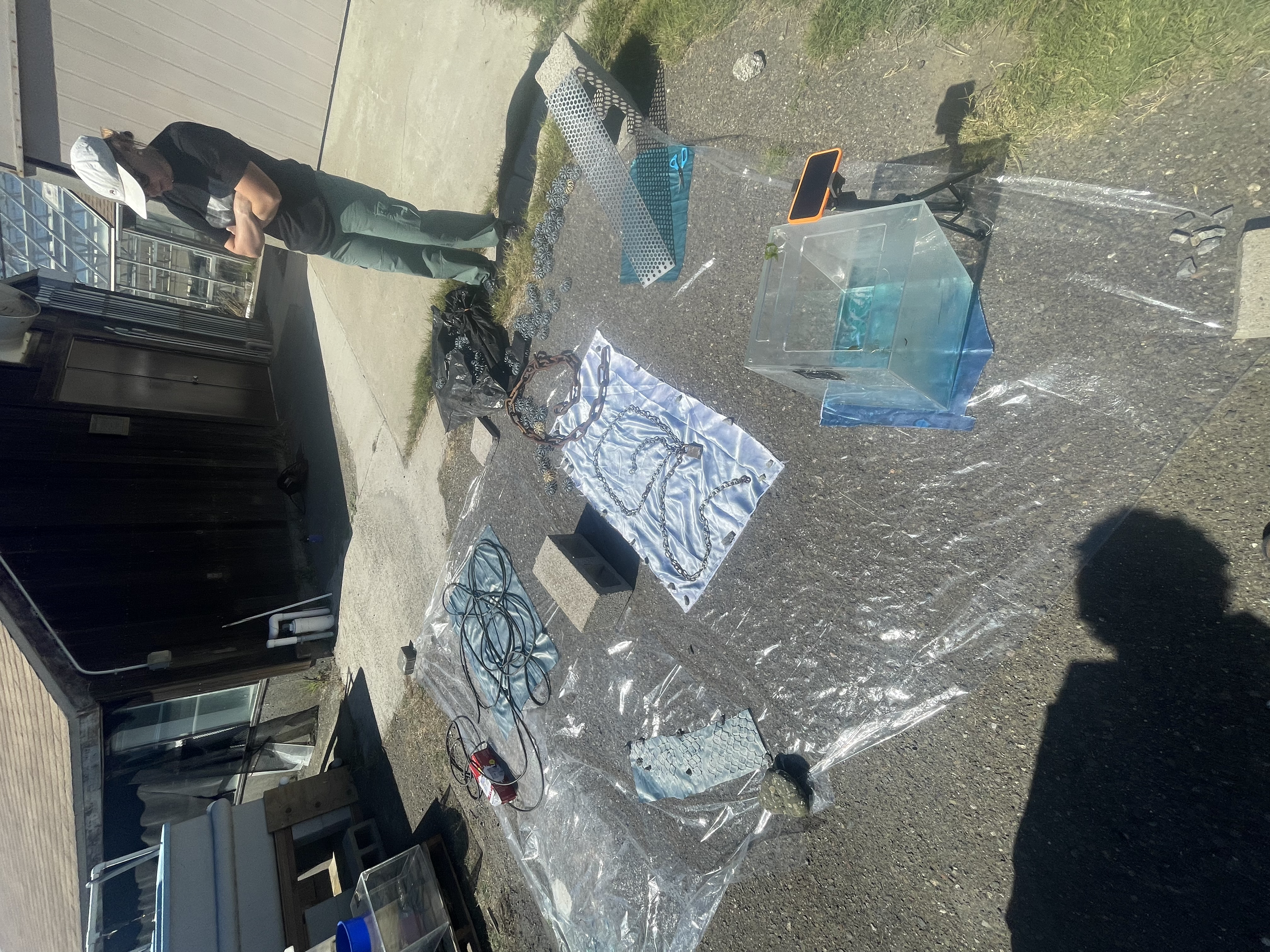
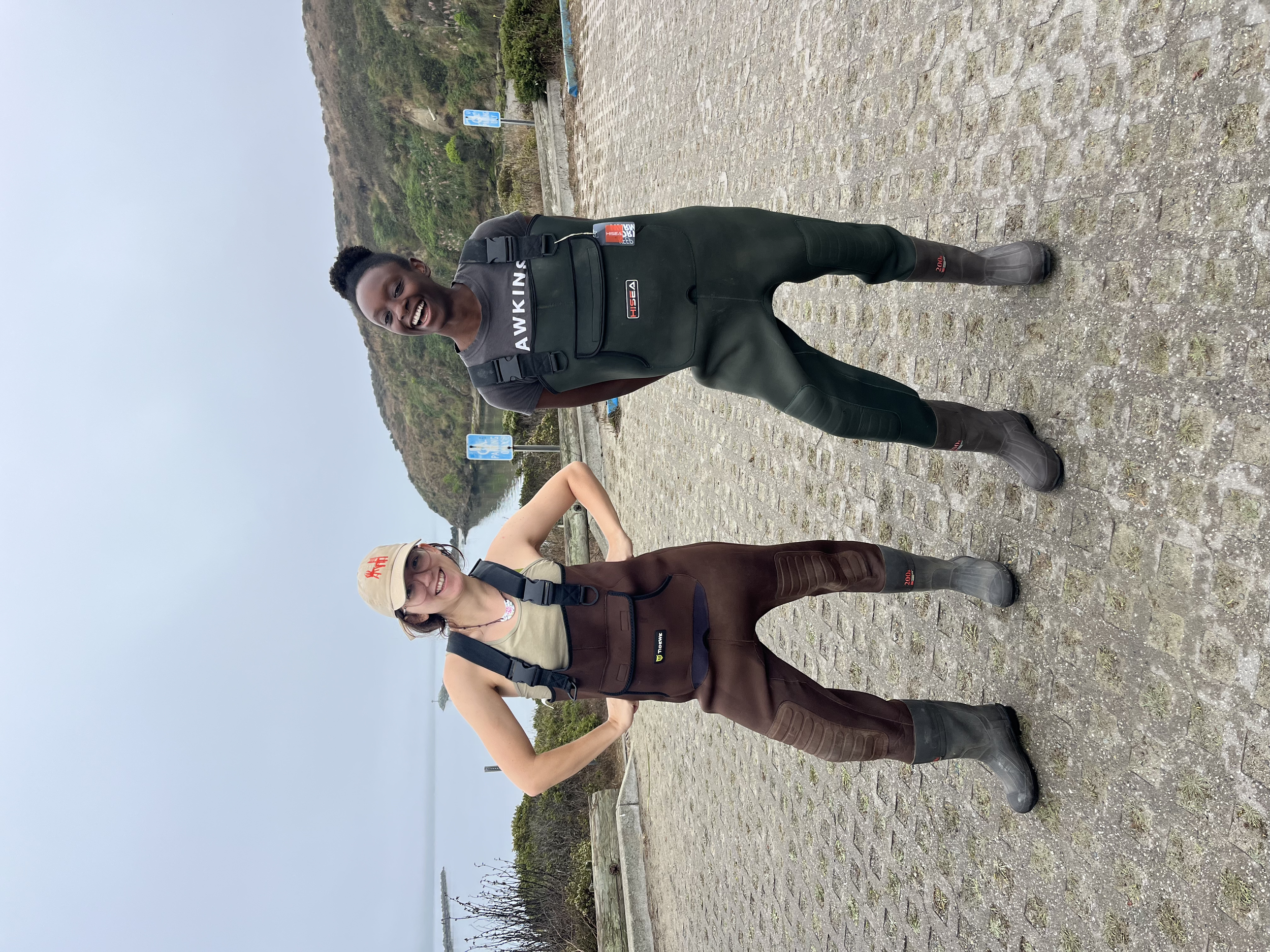
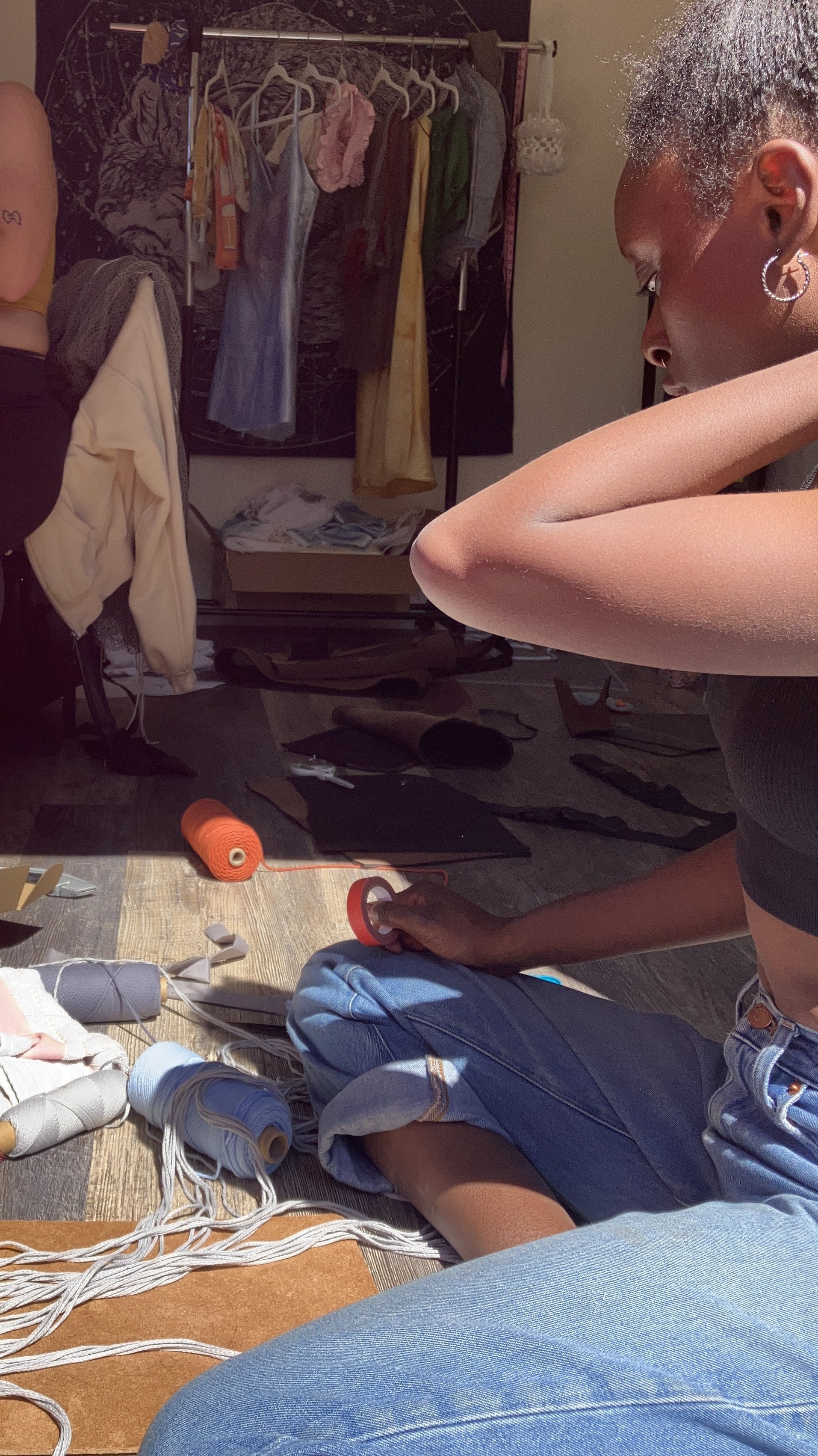
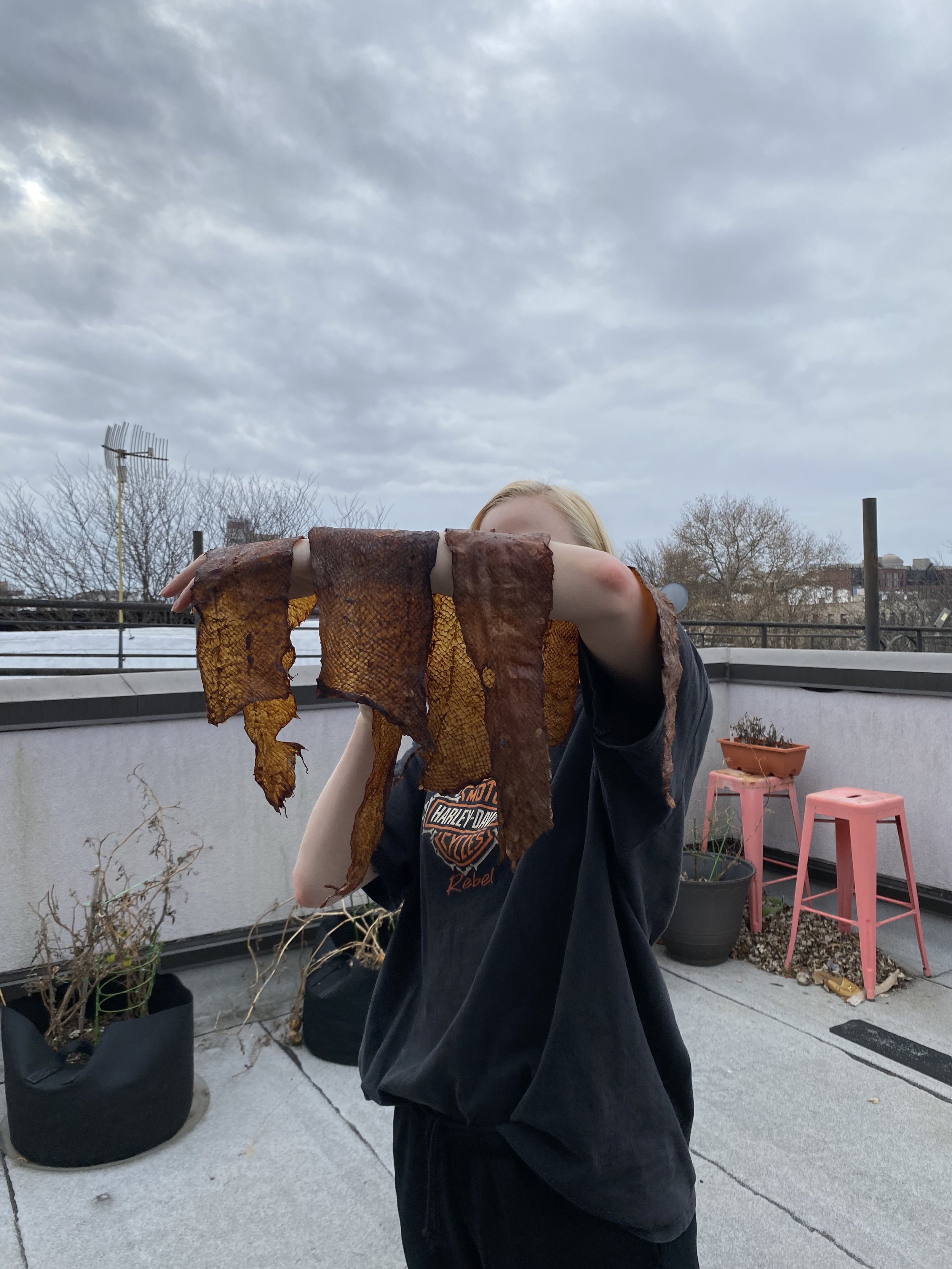
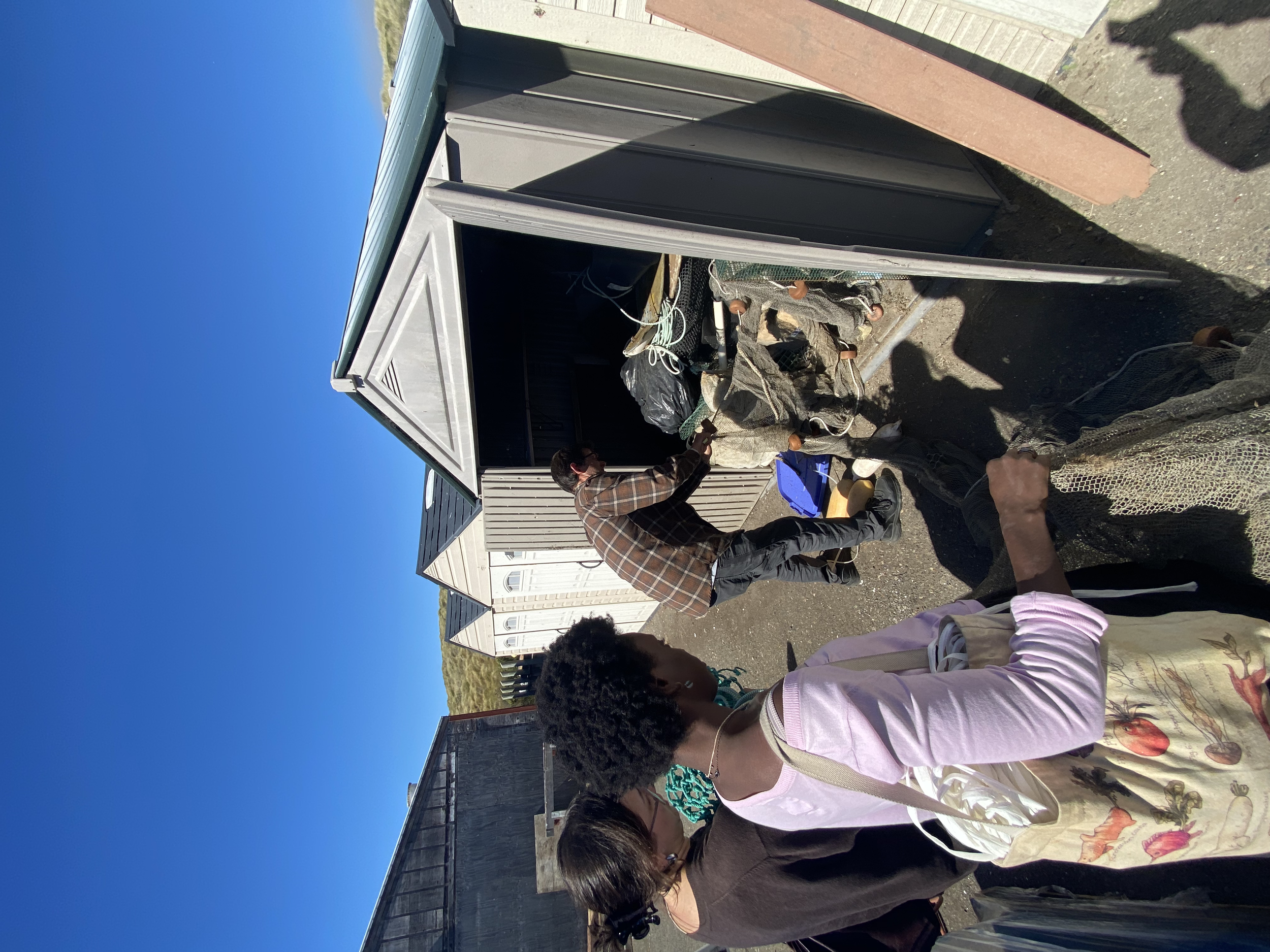

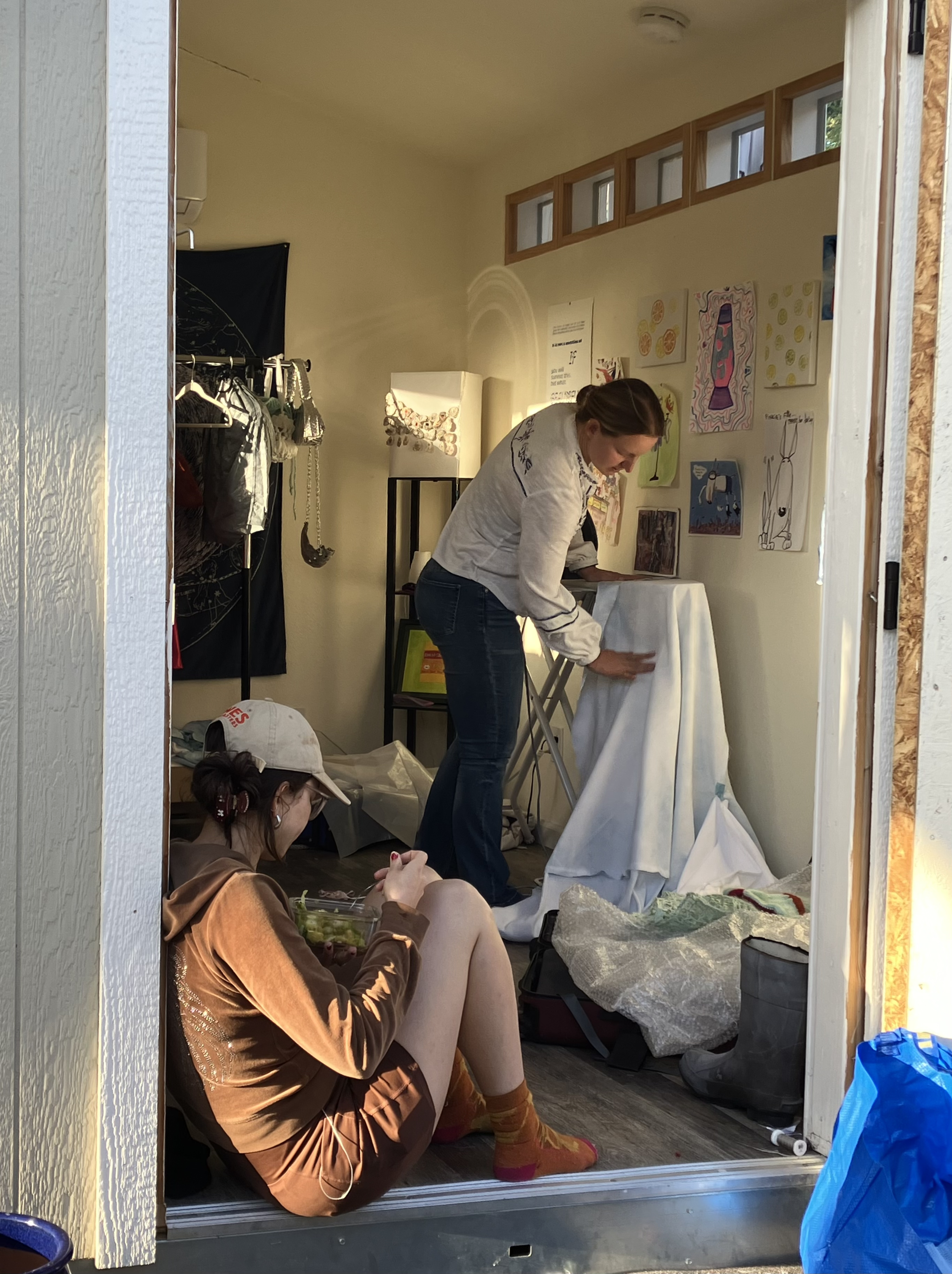
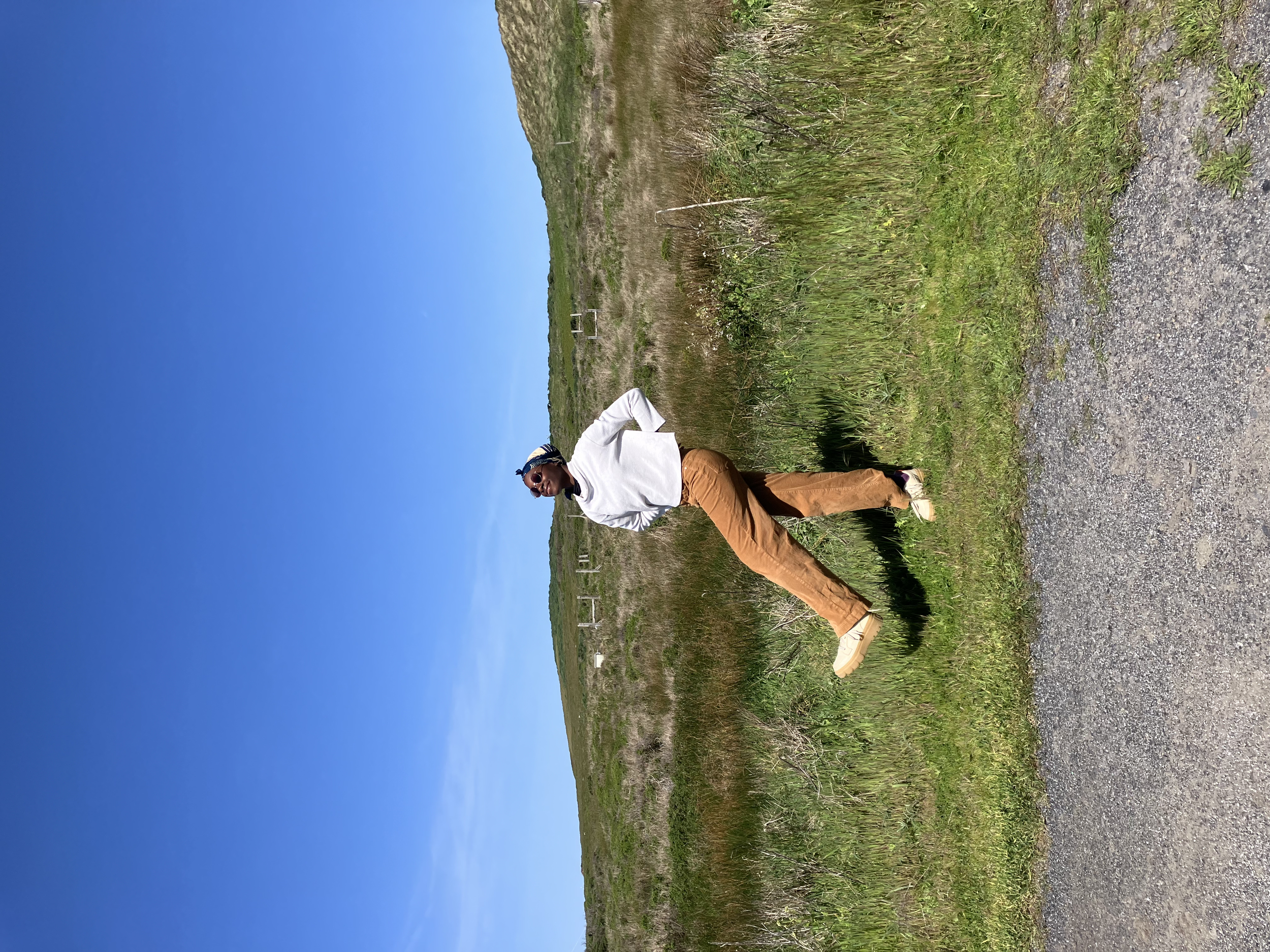

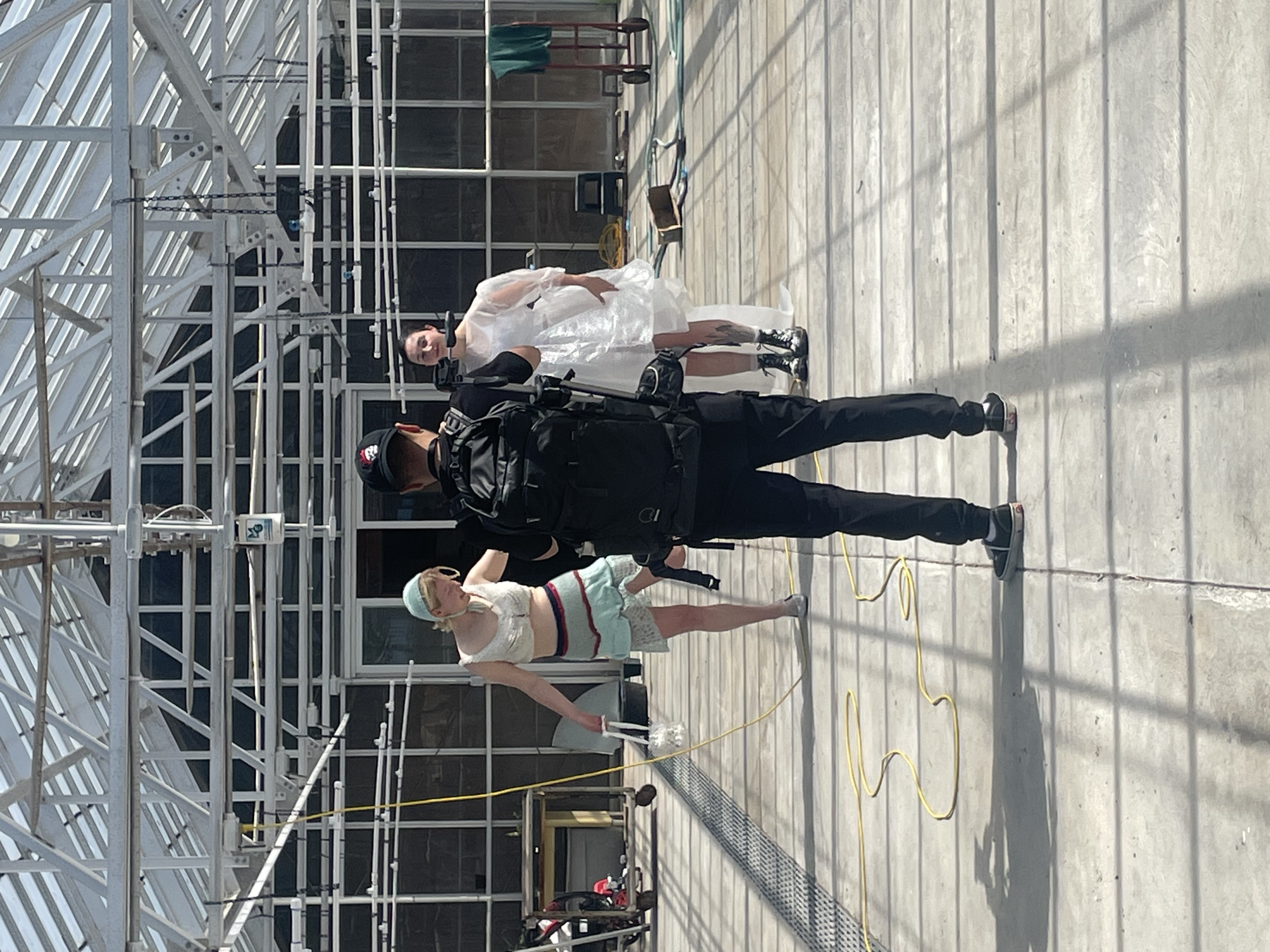
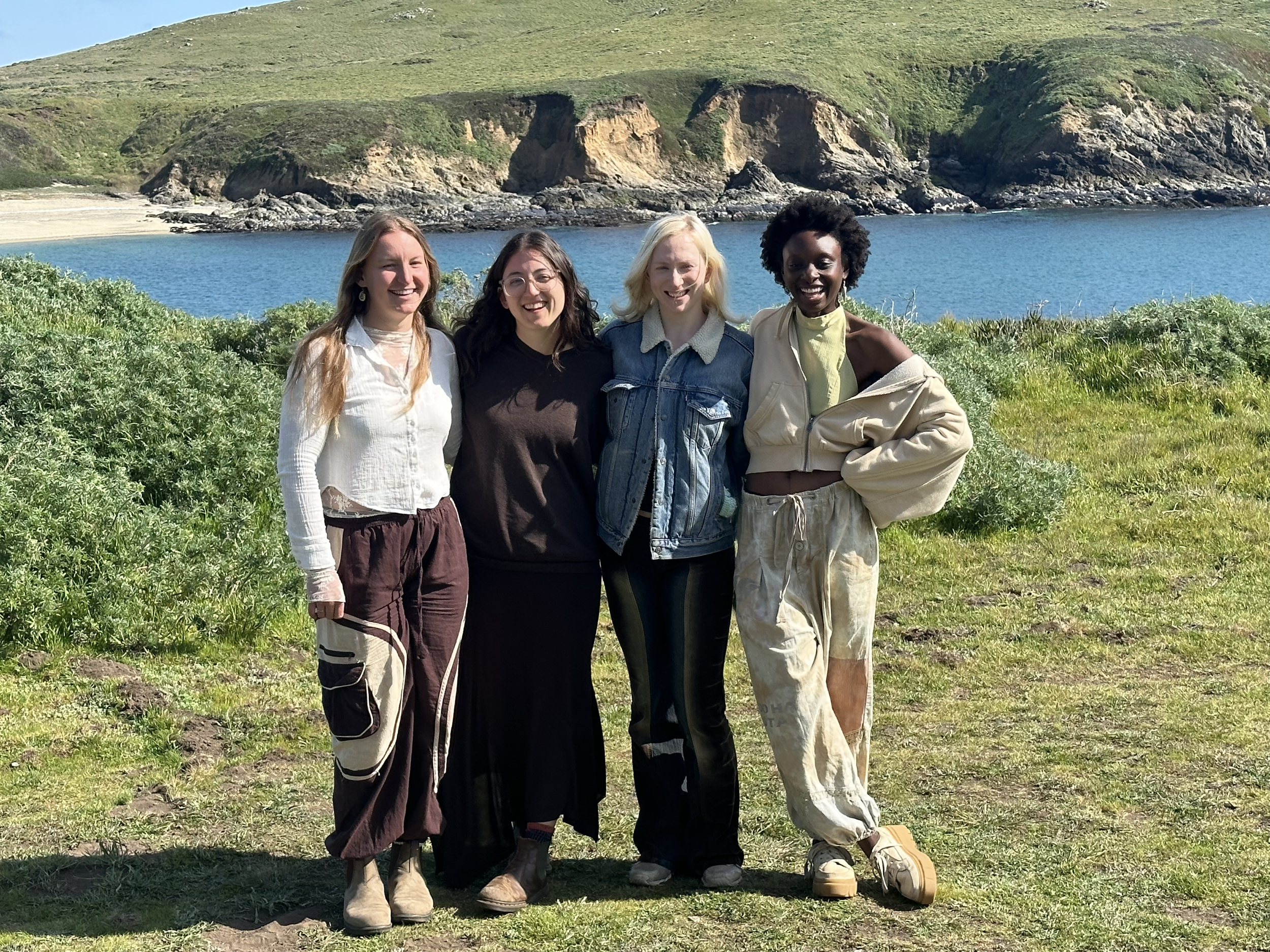


Collaborators
-
sewist, glass artist, marine evolutionary biologist
is an artist and scientist whose research on marine ecology and evolution inspires the basis of this project. Erickson studies how organisms adapt to their local environments as a method for understanding how they have and will respond to changing environmental conditions. Her primary subject is eelgrass, a species from which she’s collected over 1000 samples all along the California coast.
-
designer, sewist, computer scientist
is a multimedia artist who makes clothing with an emphasis on using found and repurposed materials. She experiments with shapes, textures, and ways of recycling materials into new forms. Her most recent ongoing project is constructing garments – jackets, overalls, vests – out of repurposed tote bags from her neighborhood. She previously showcased a fall/winter streetwear collection in 2021 Baltimore Fashion Week.
-
poet, knitter, ceramicist, computer science educator
is a multidisciplinary artist, poet, and educator based in Chicago, IL. Her written work explores themes of nostalgia and loss through connection with the natural world and has been published in Pearl Press. Themes of sentimentality, abundance, and impermanence persist throughout her work in other mediums including ceramics, confectionery, collage, and knitwear.
-
knotter, weaver, forager, mechanical engineer
is a fiber artist, designer, forager, and owner of Unknot, a handmade accessories studio. Thiam explores and experiments in the traditional mediums of macrame and weaving, pairing playful colors and thoughtful design to make functional, contemporary, easy-going pieces. She writes, “The traditional West African tapestries ever-present in my upbringing influence the bold colors and soft structures in my art.” Thiam enjoys working with common macrame materials of cotton and paracord, but is steadily integrating other materials–foraged grasses, needles, and vines, reclaimed materials like plastic bags or fishing net, algae-based bio yarn and knitted cord–into her work.
